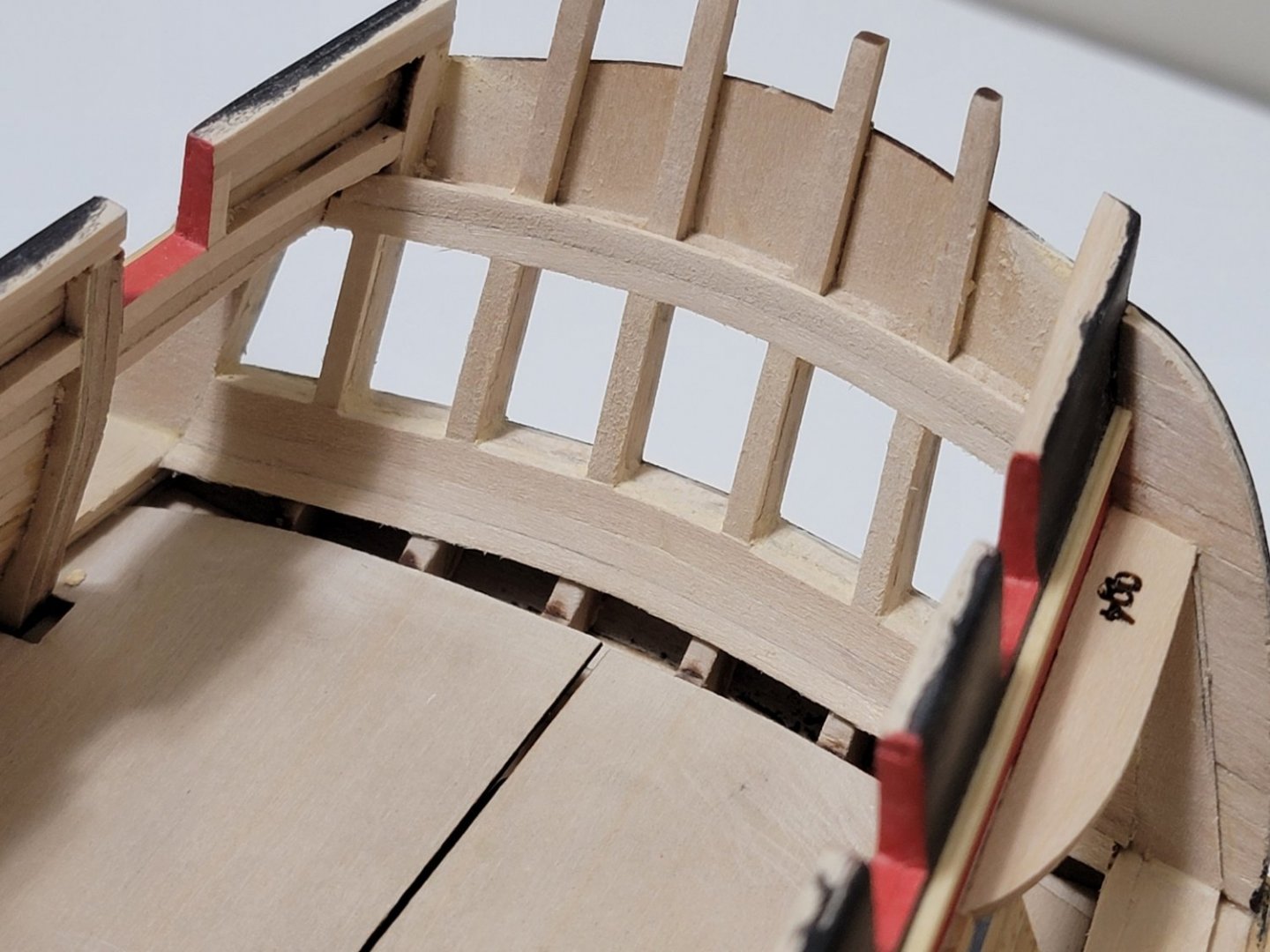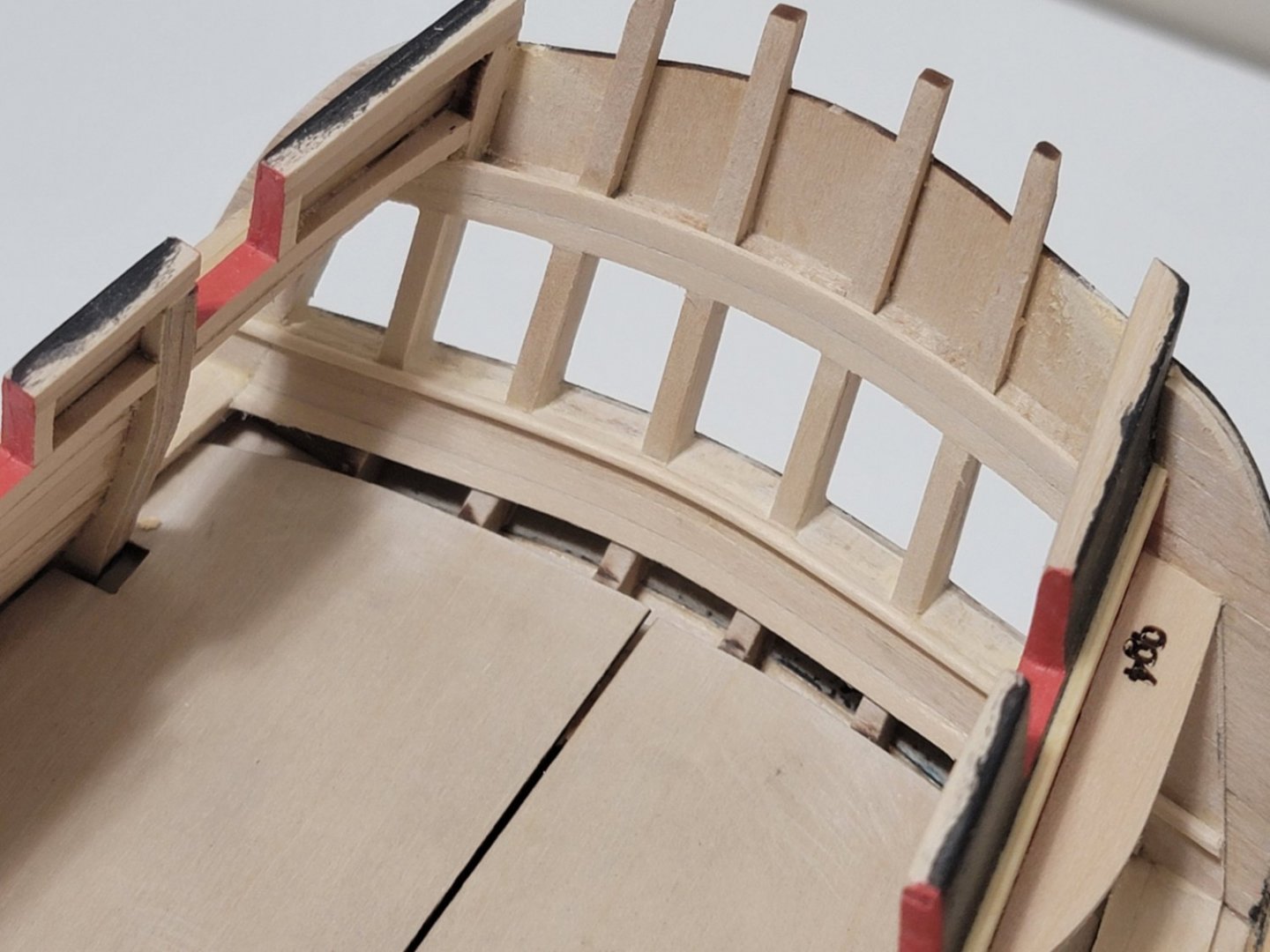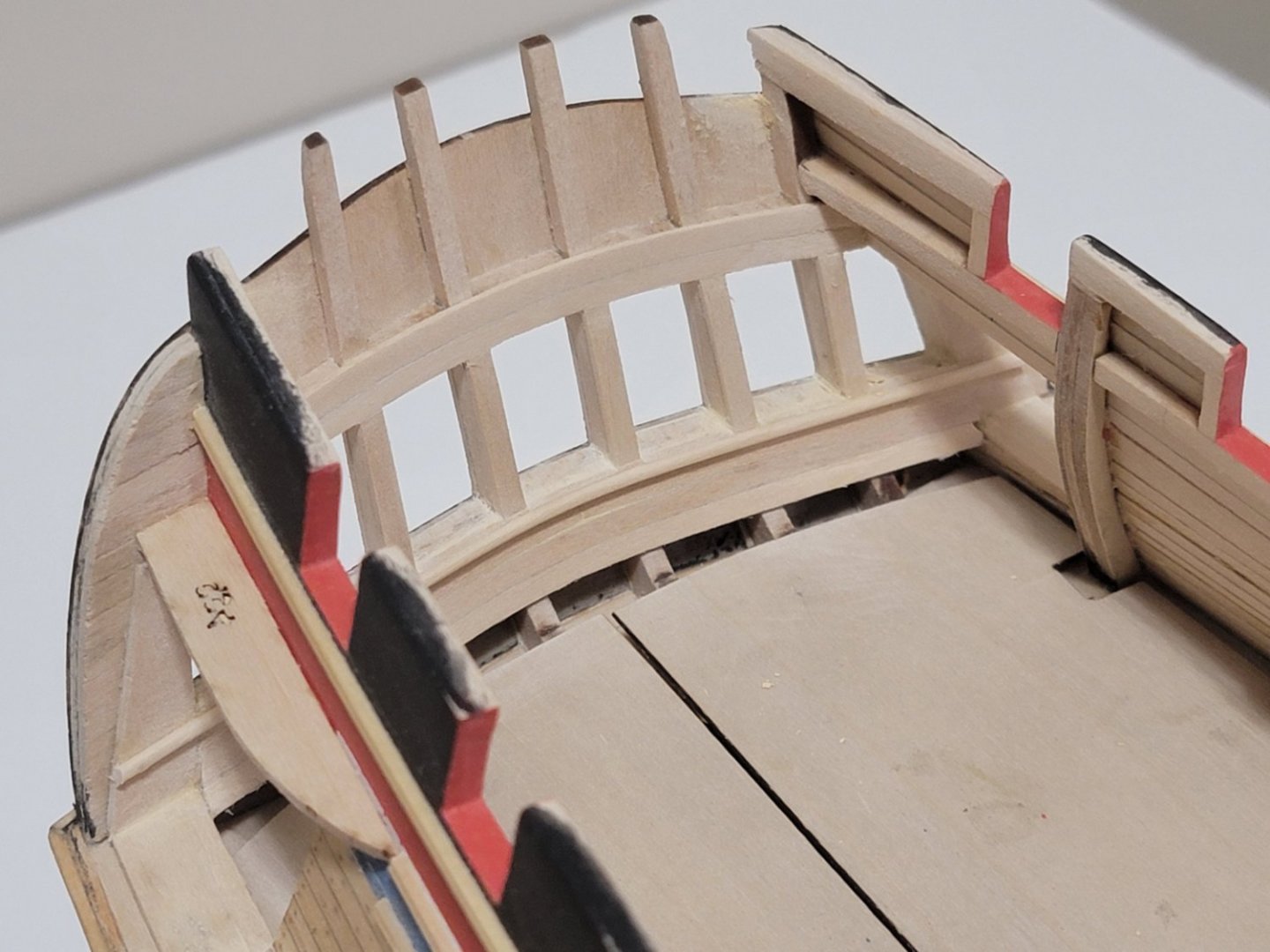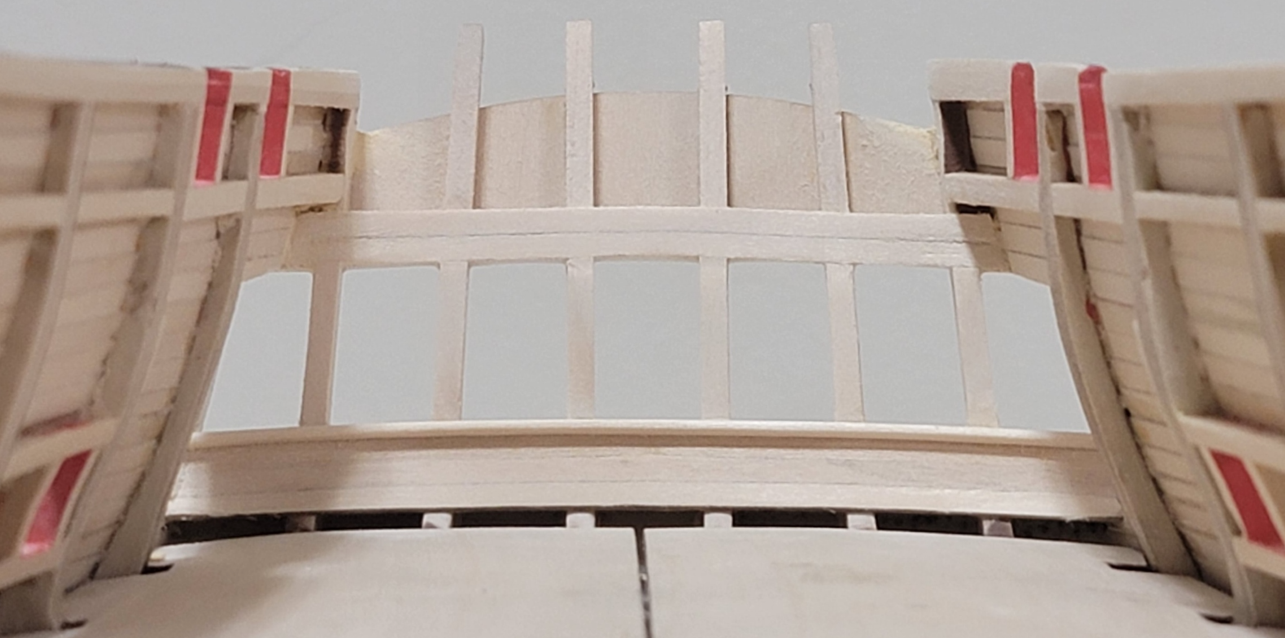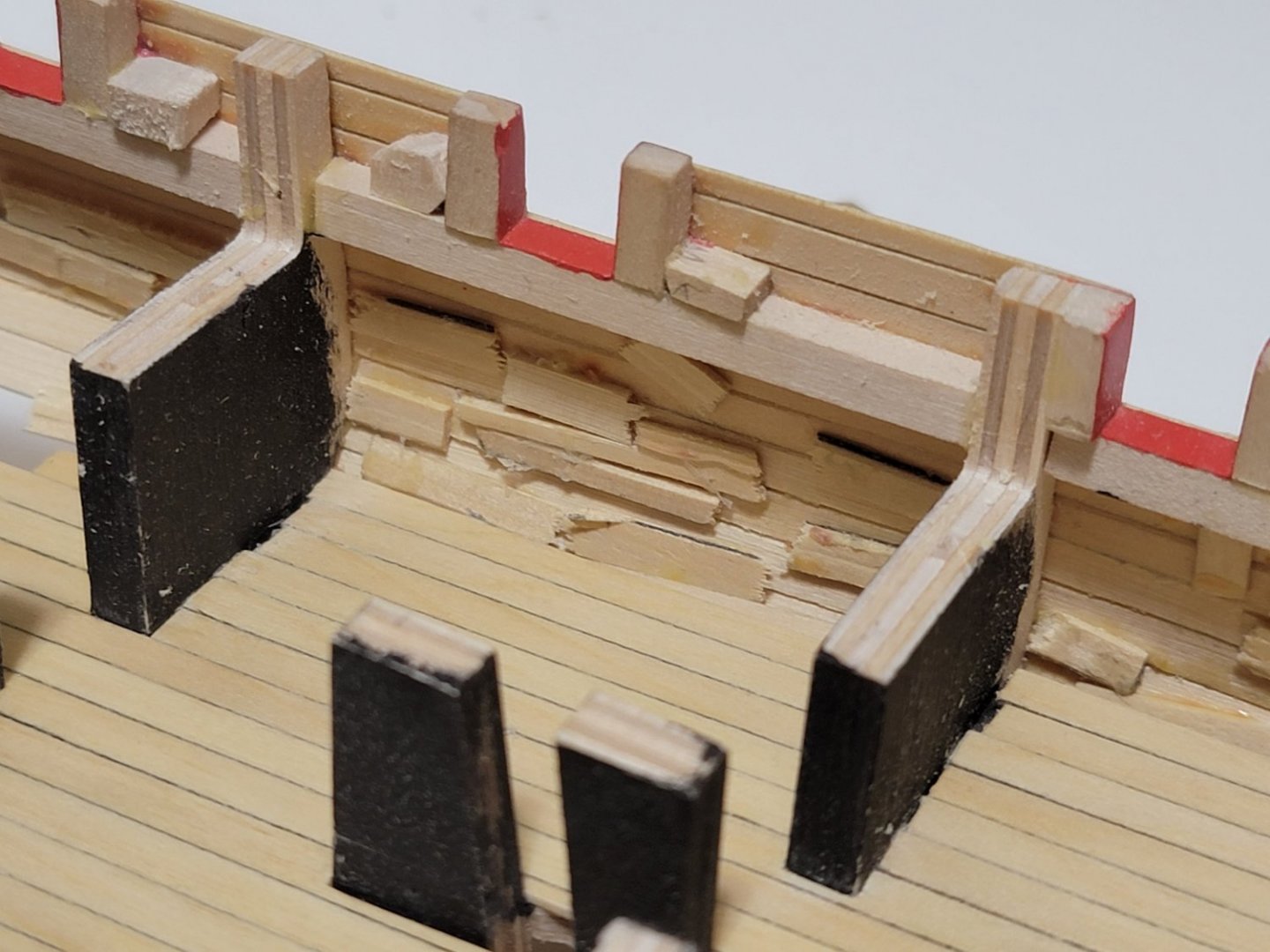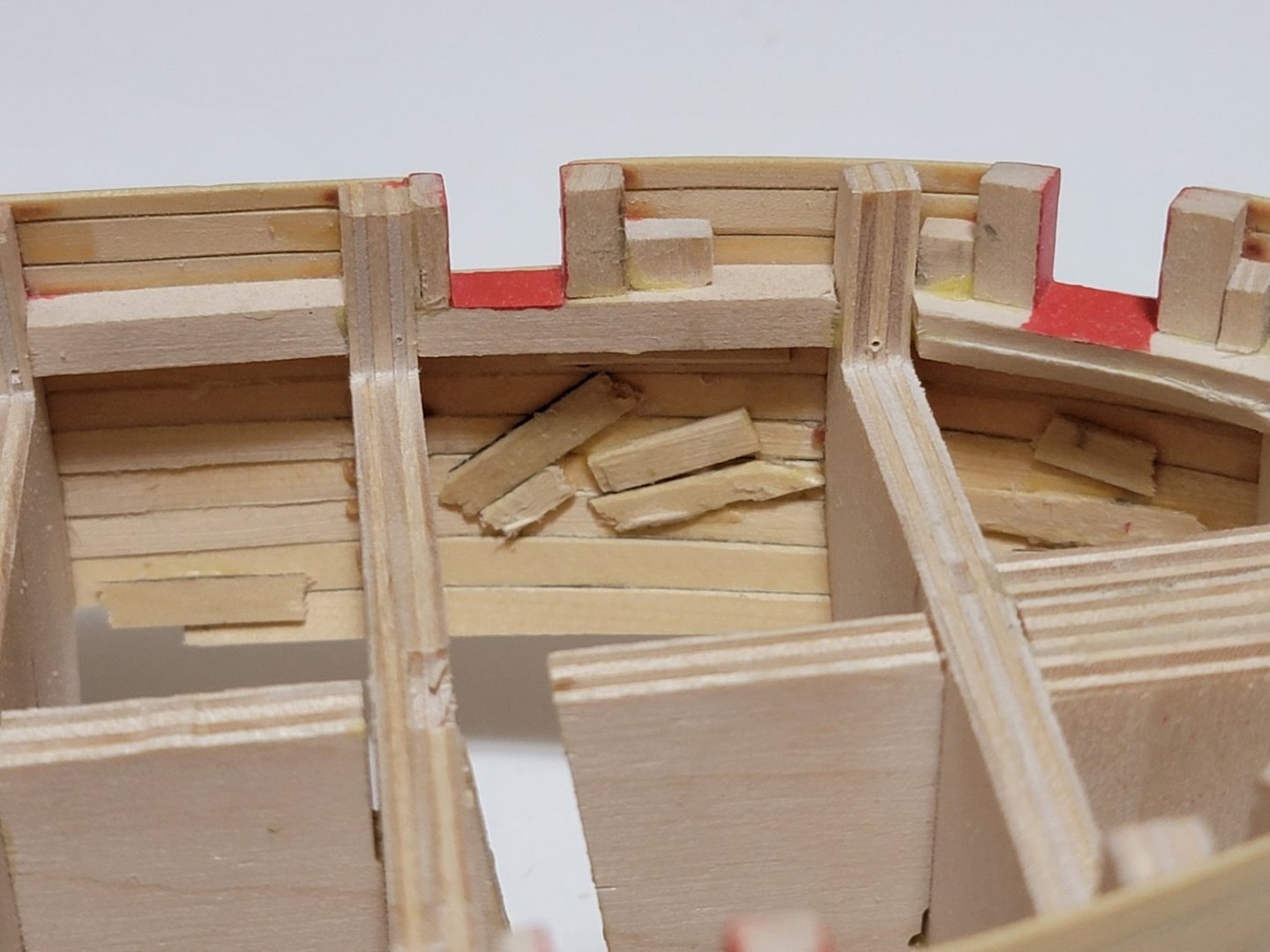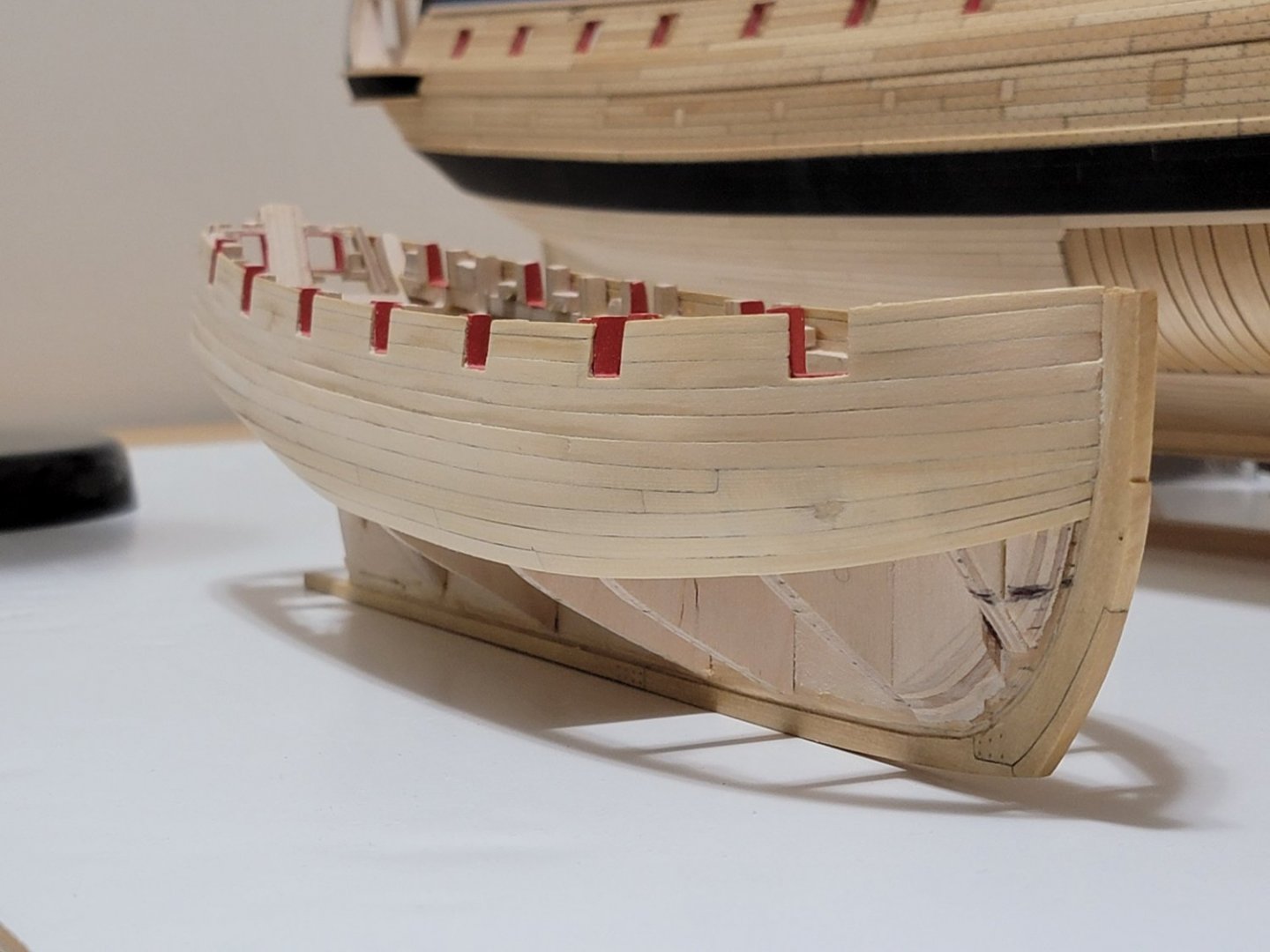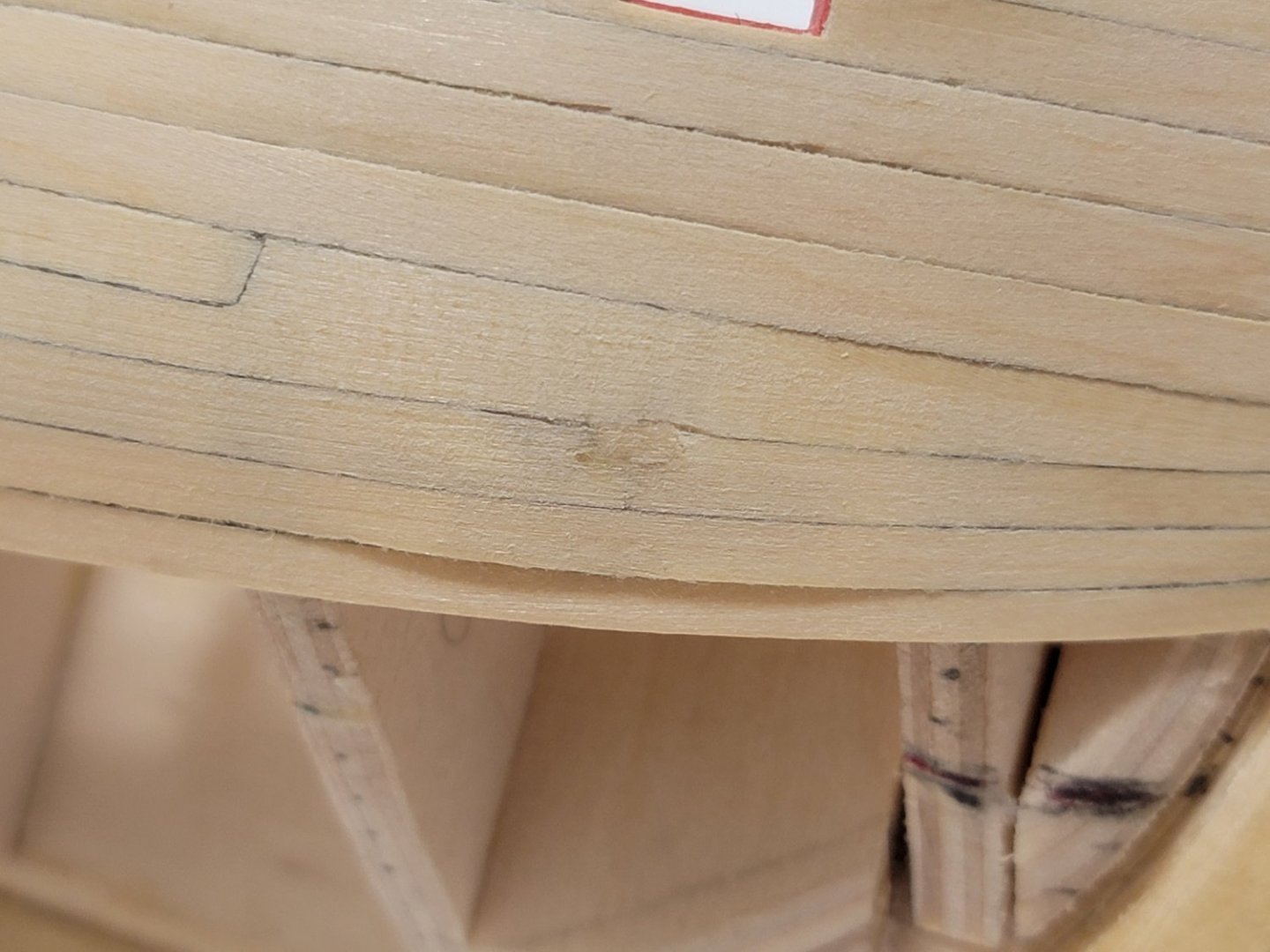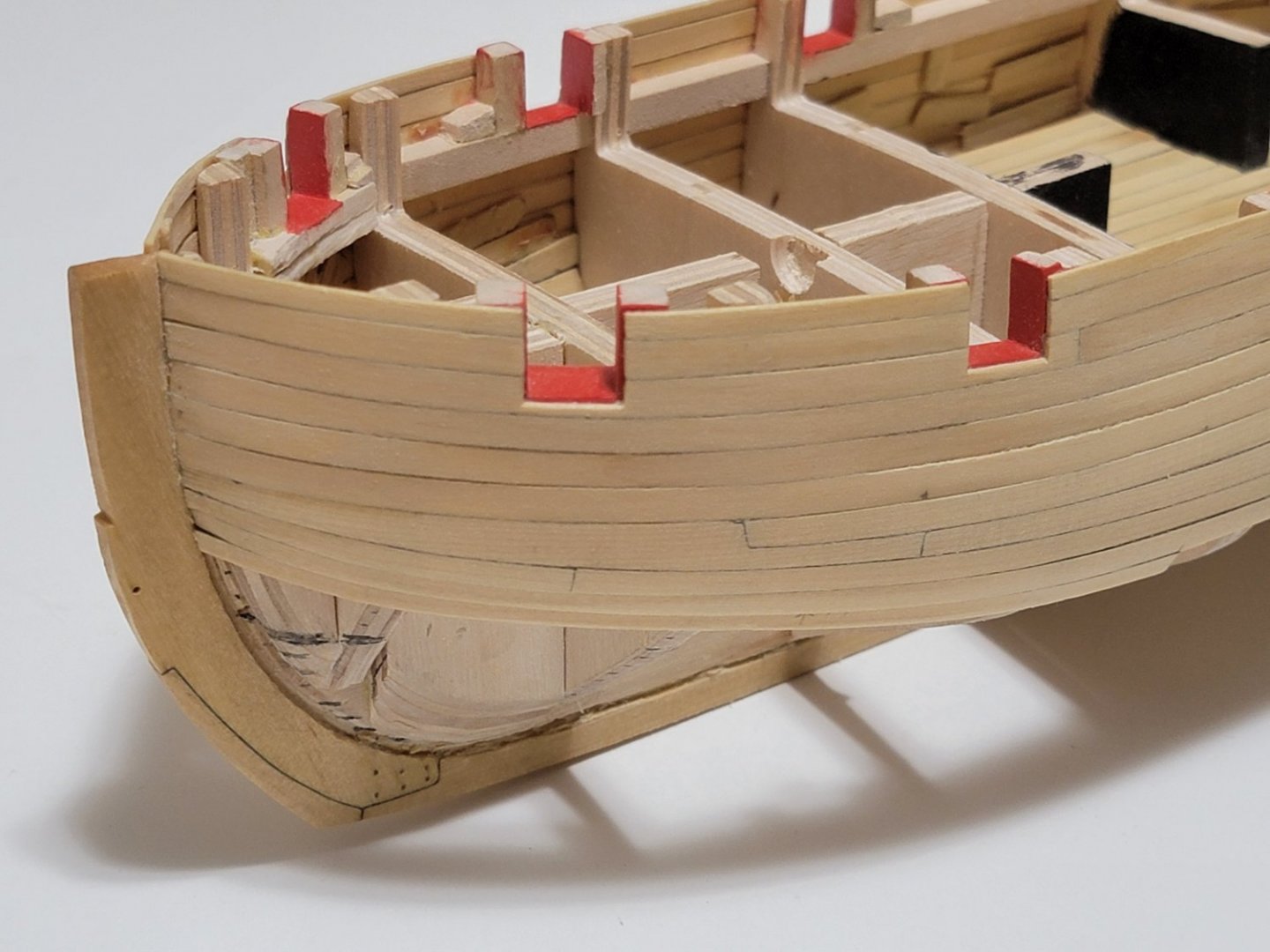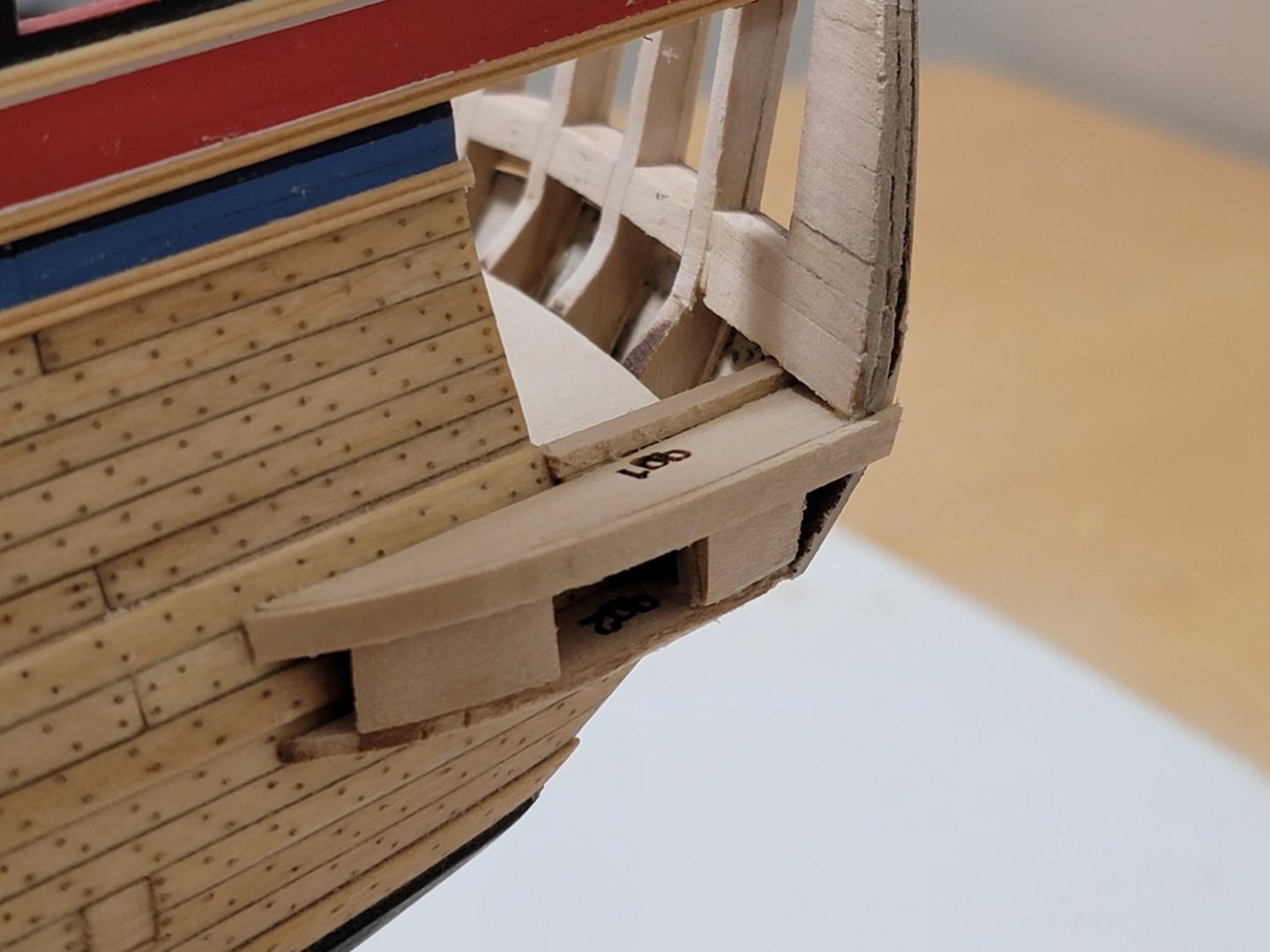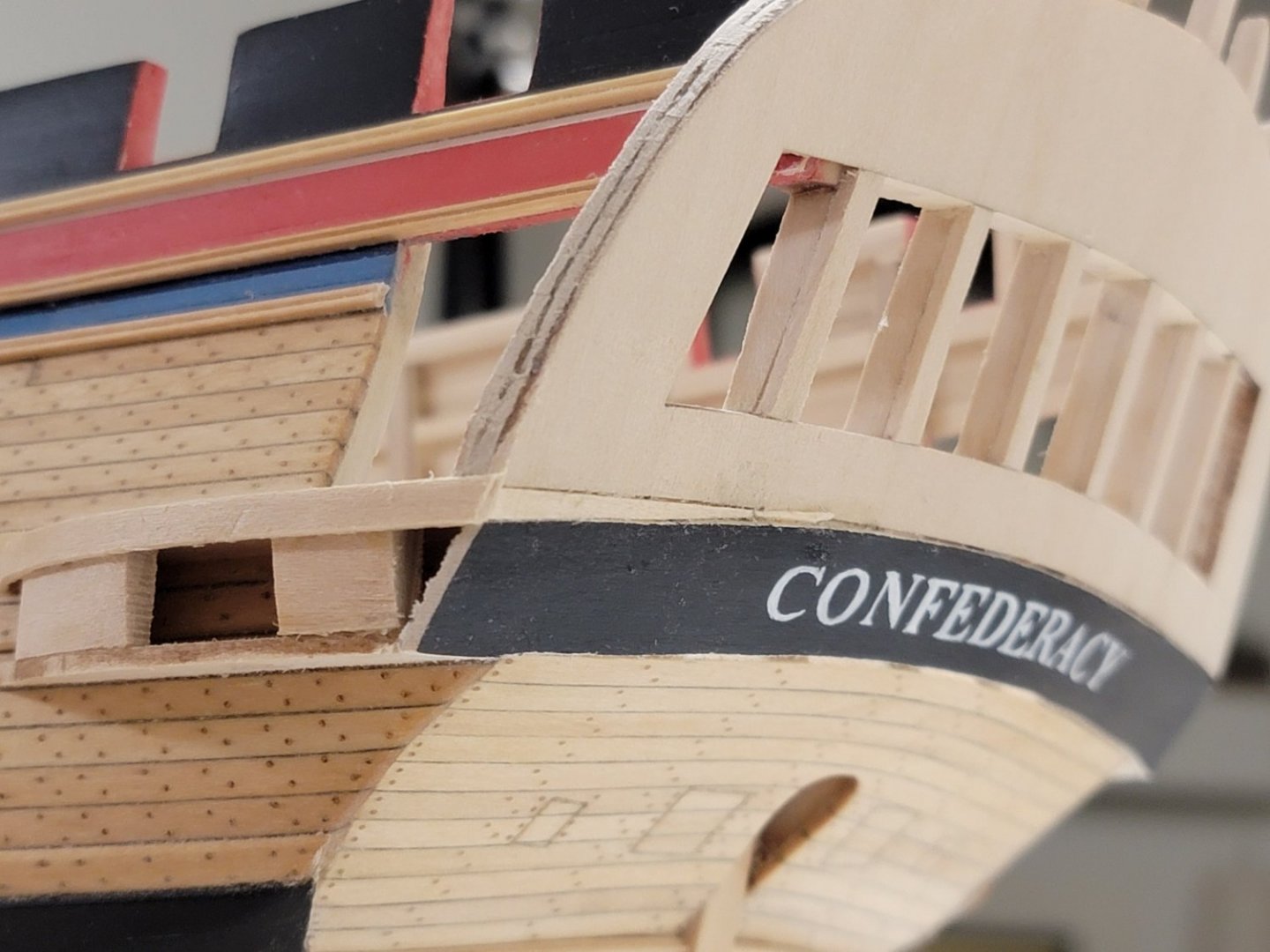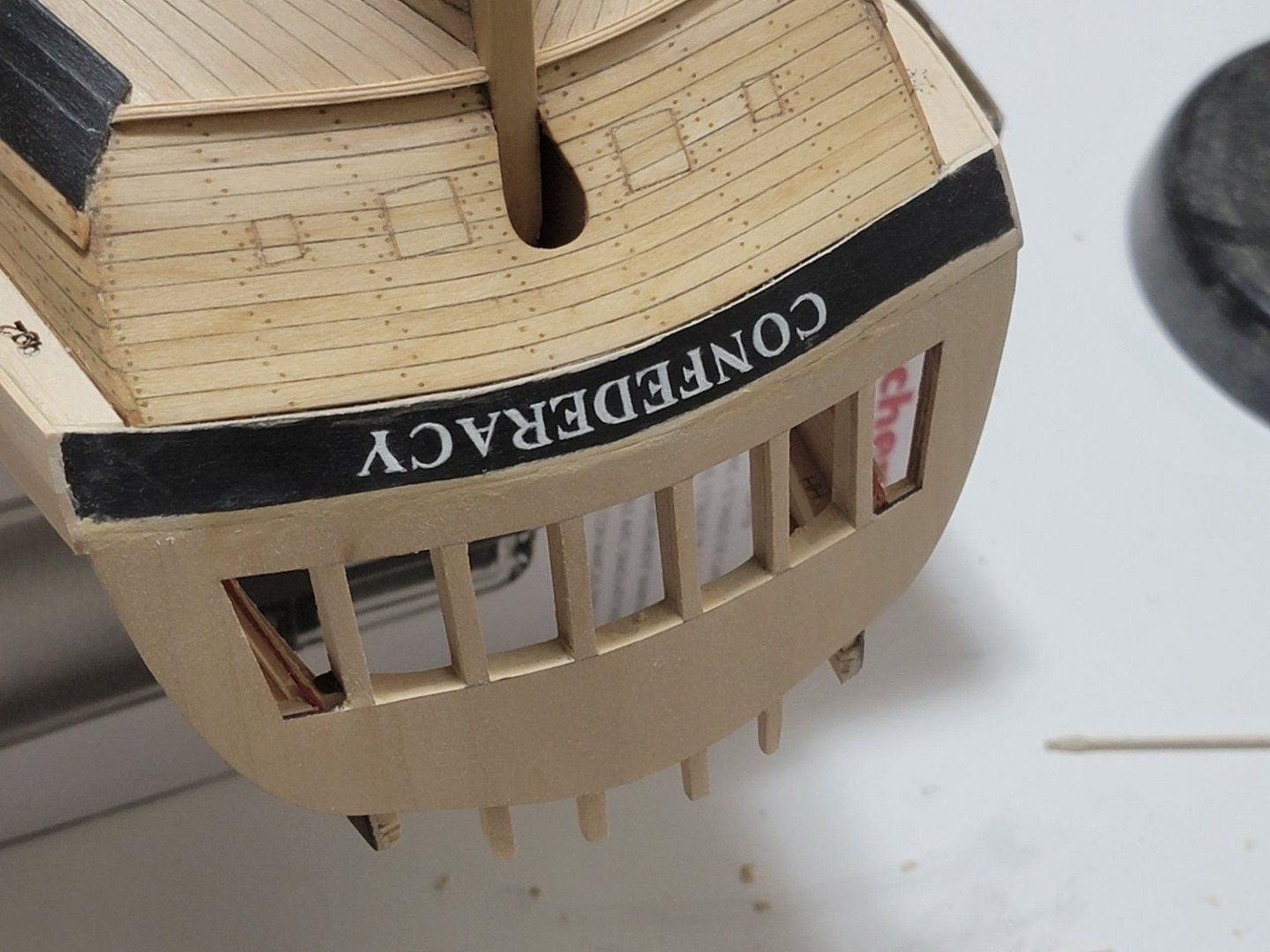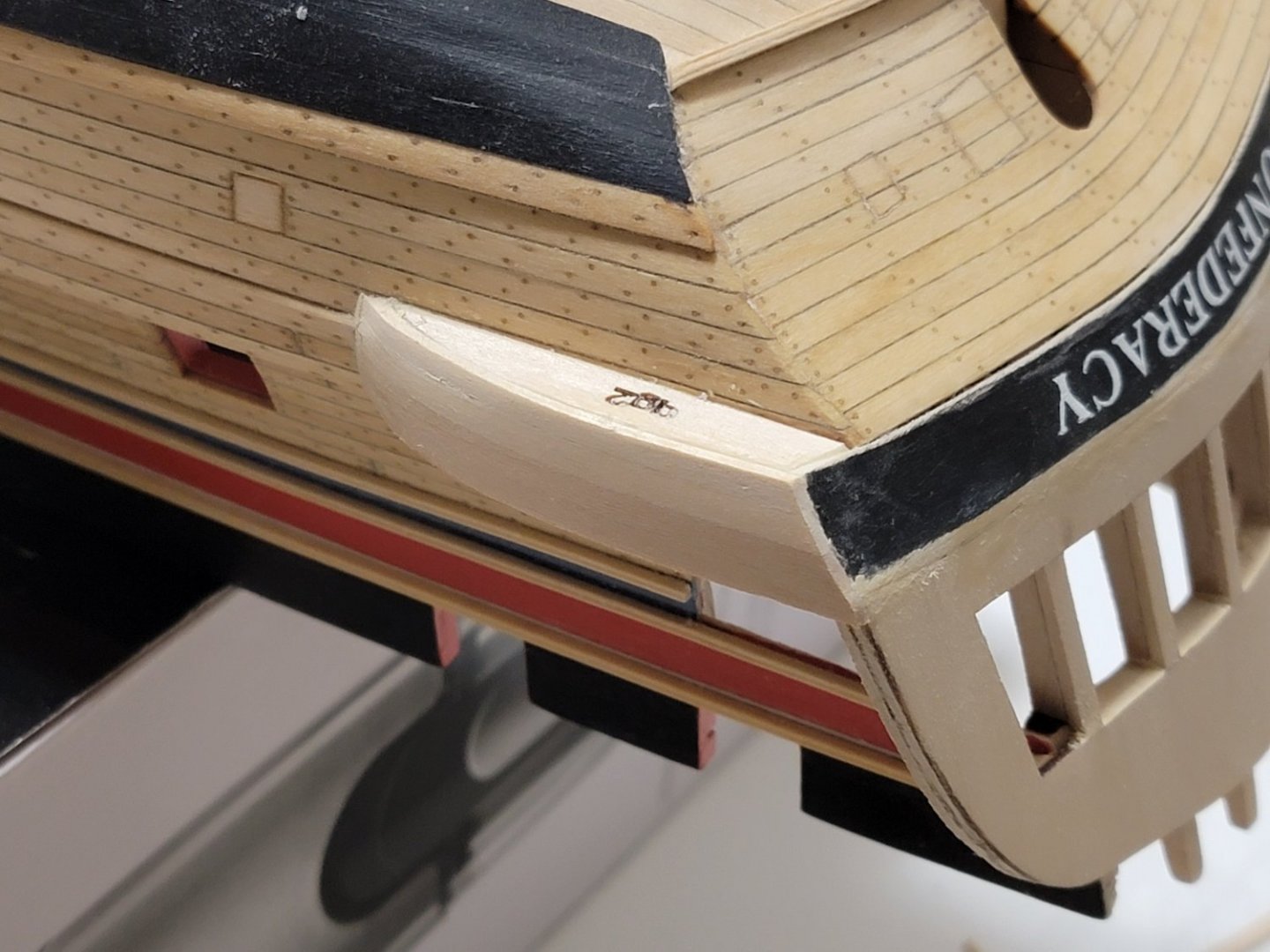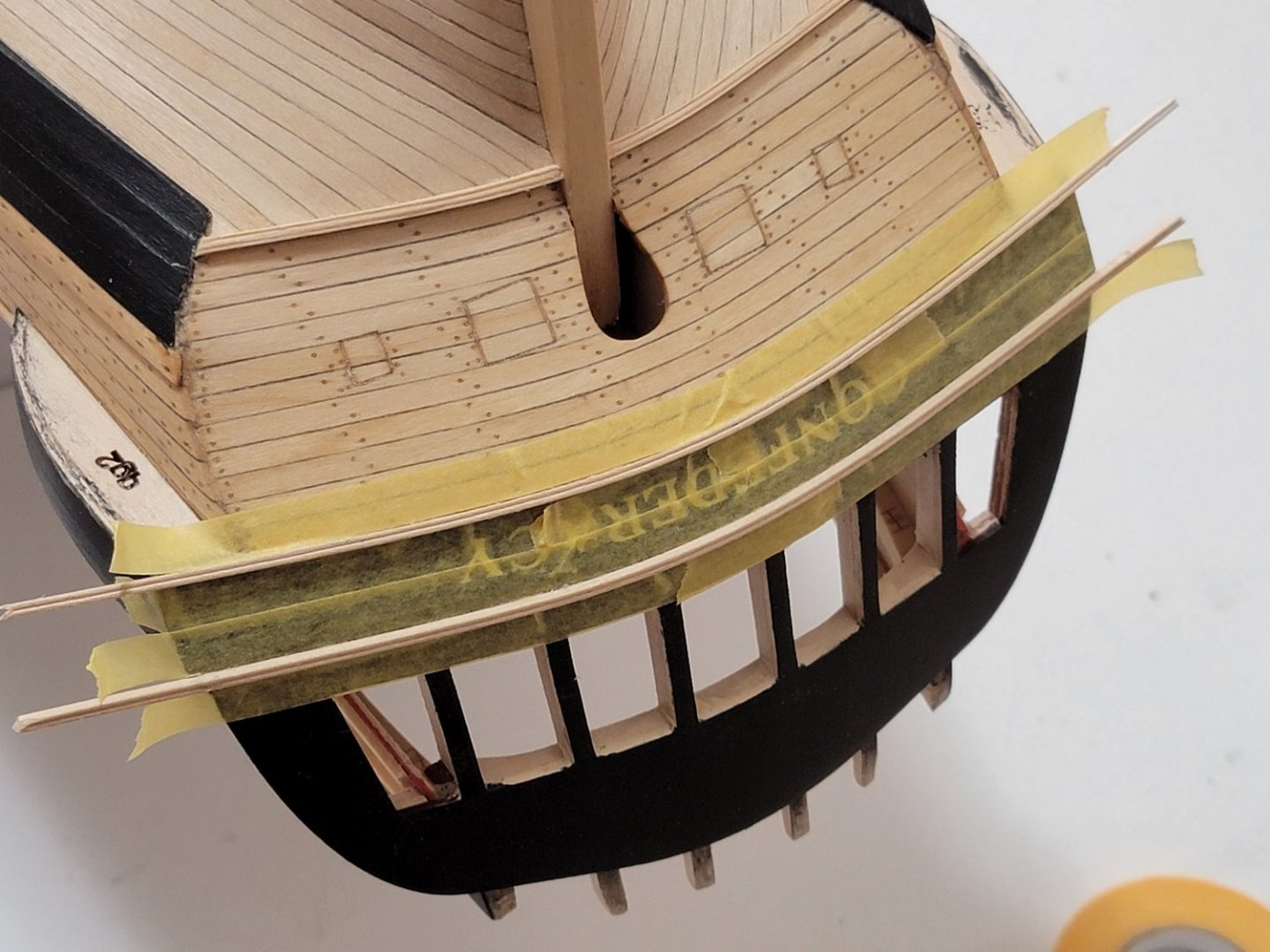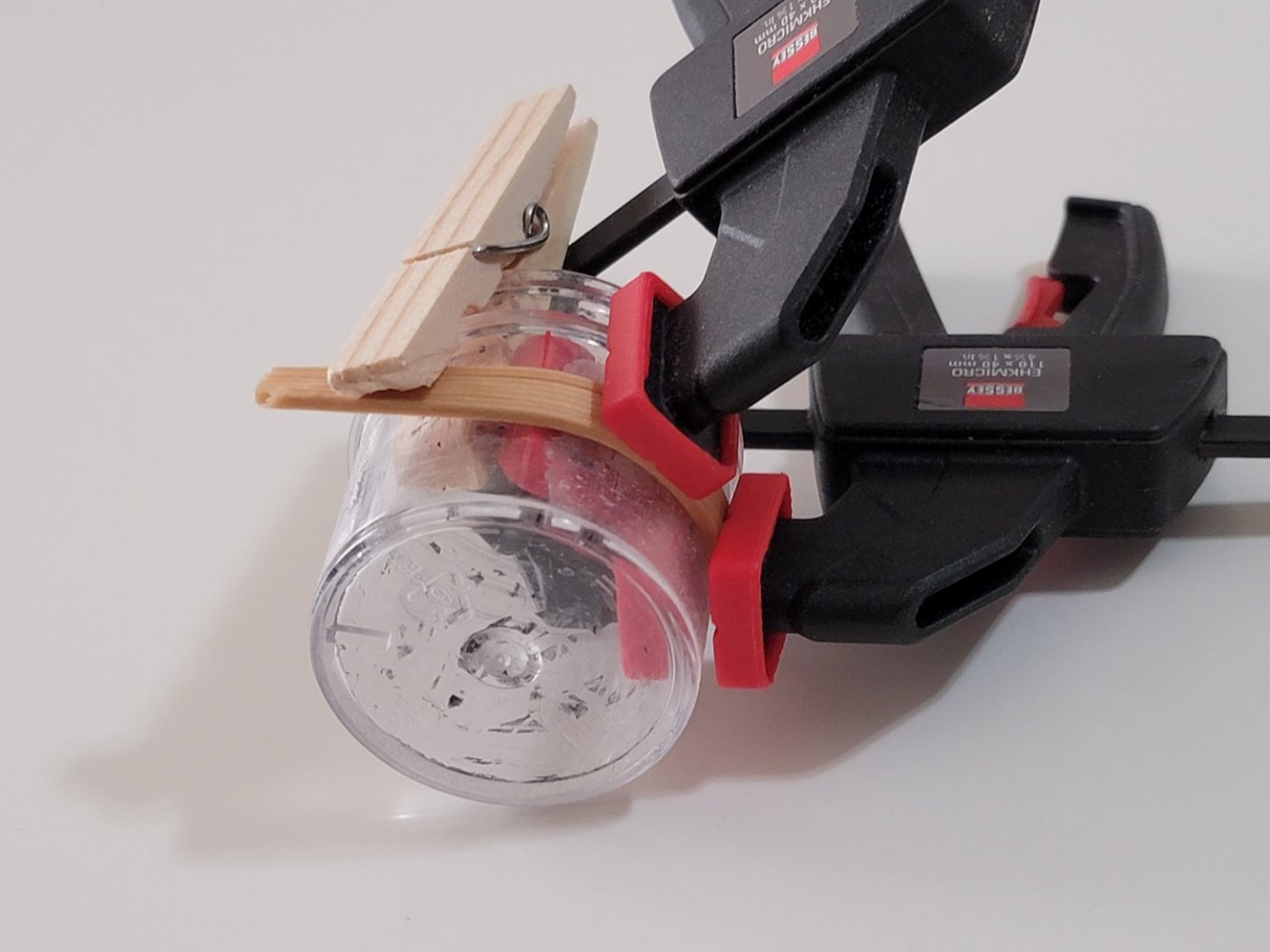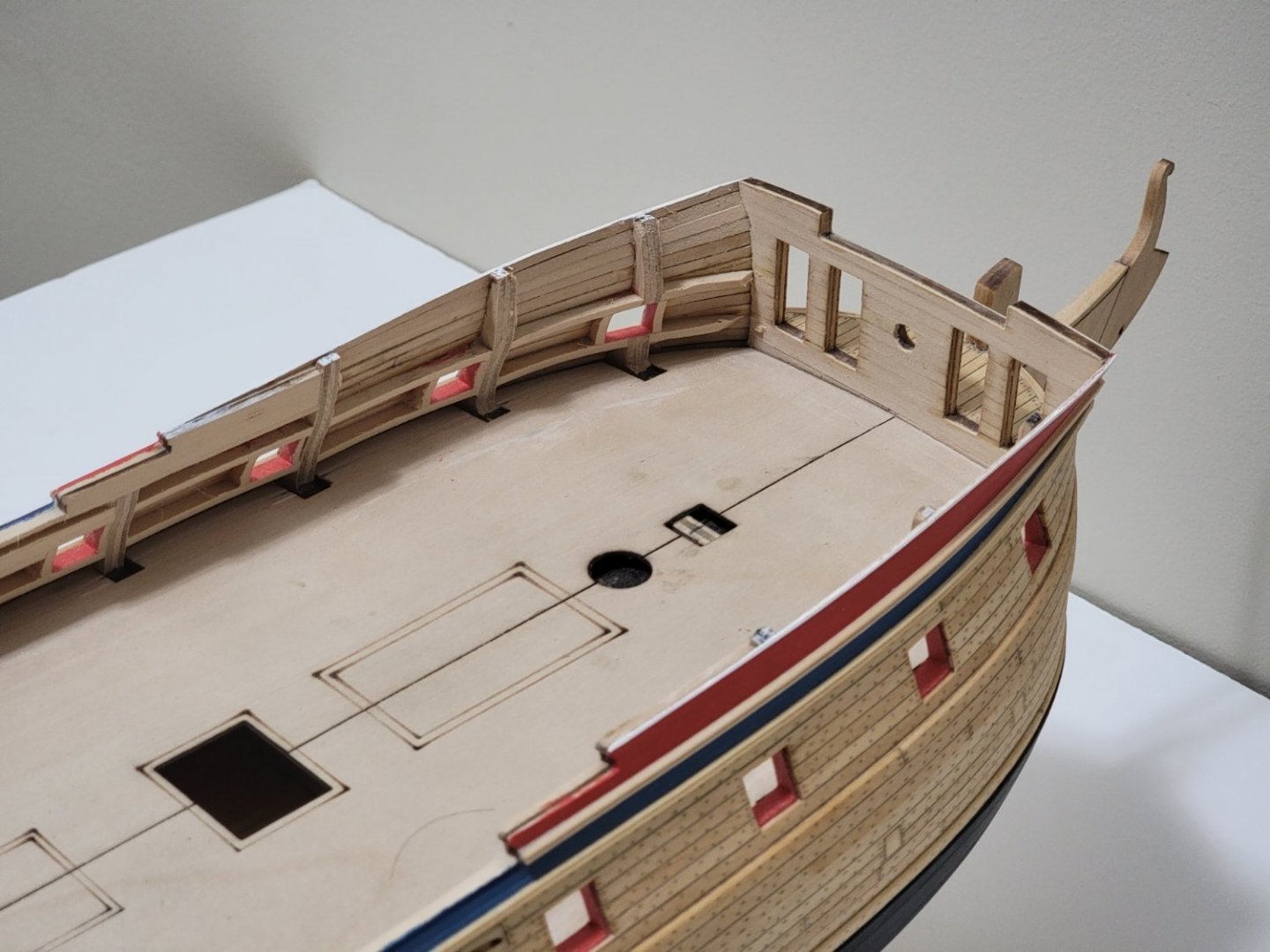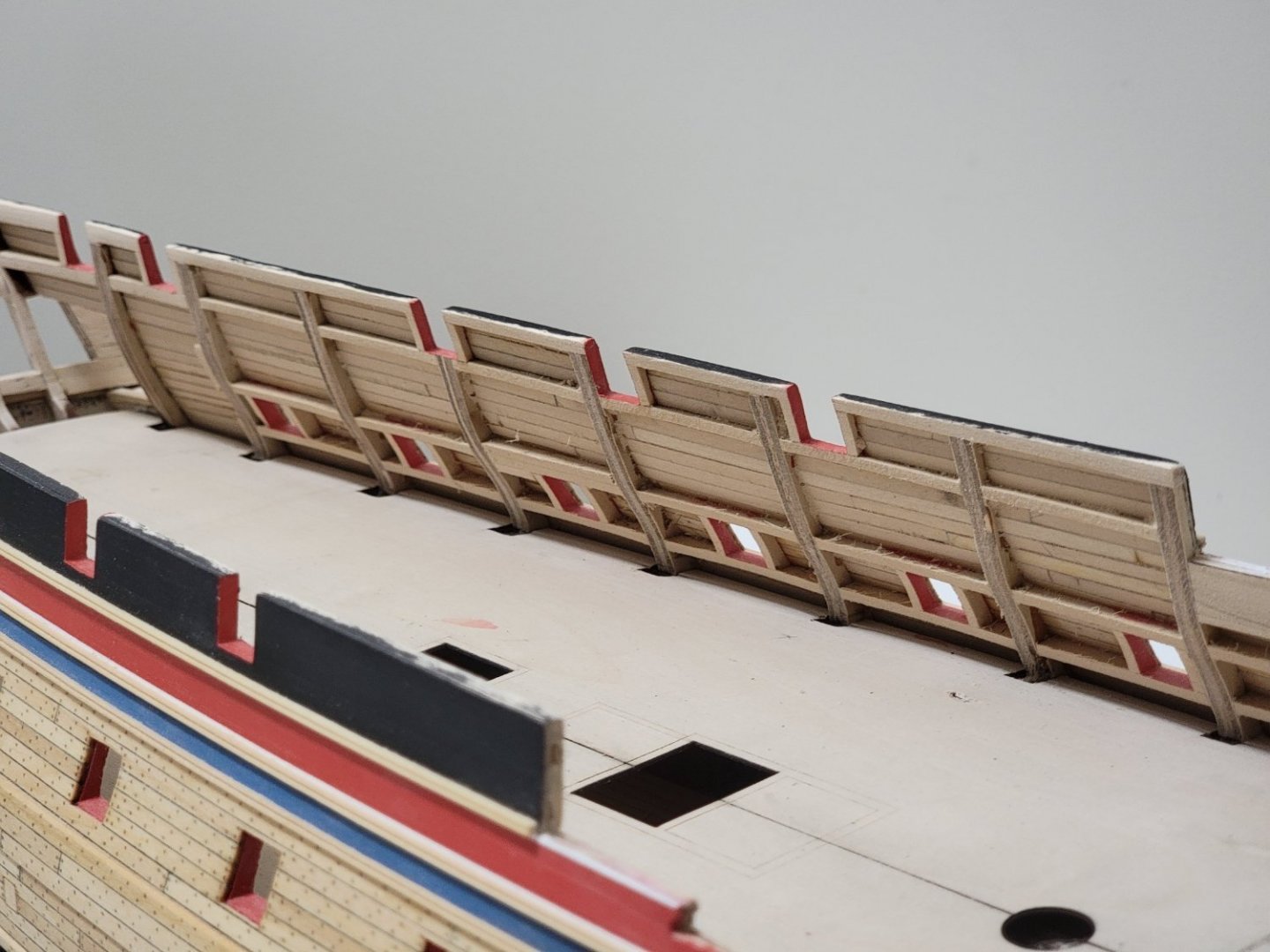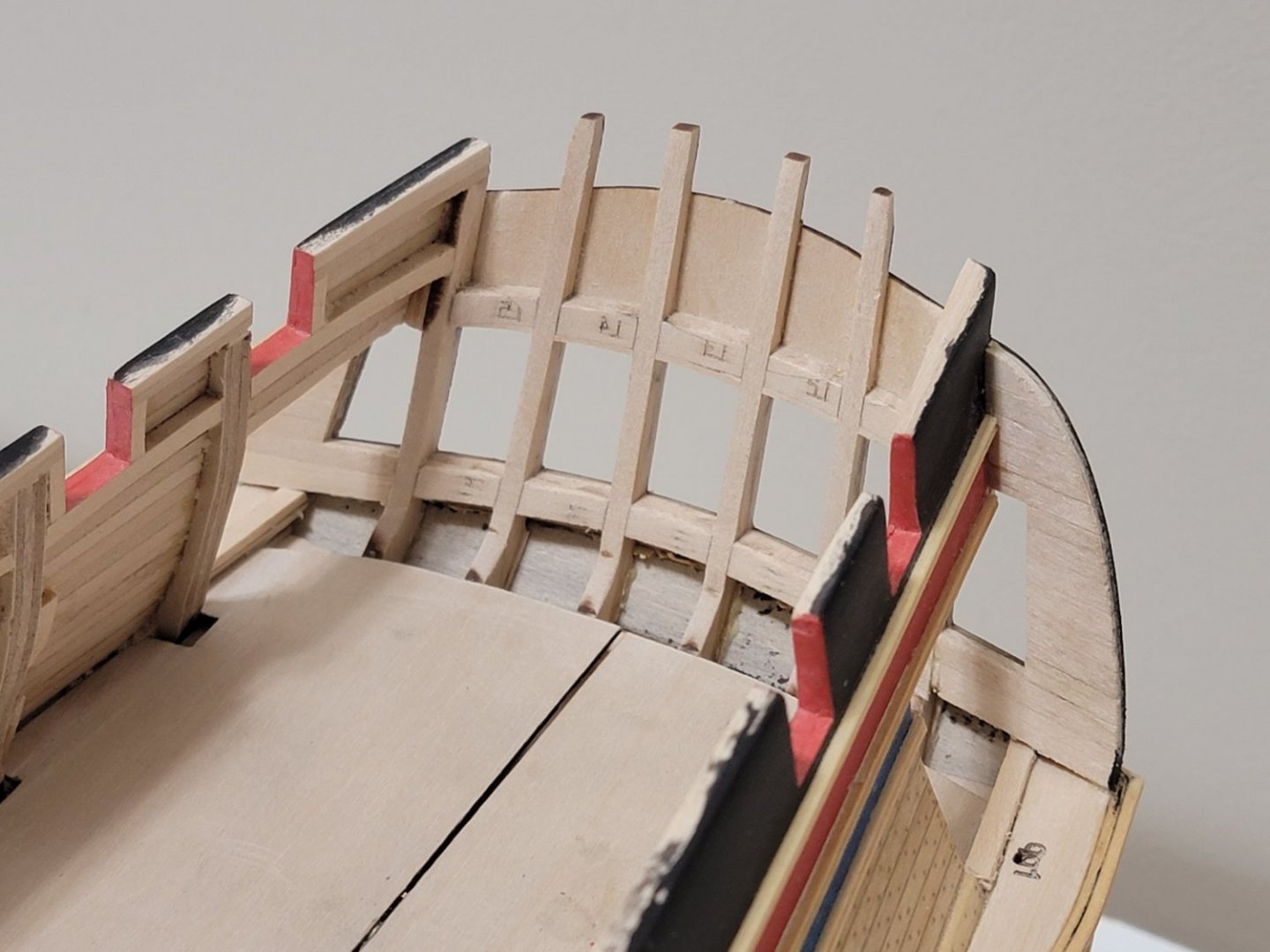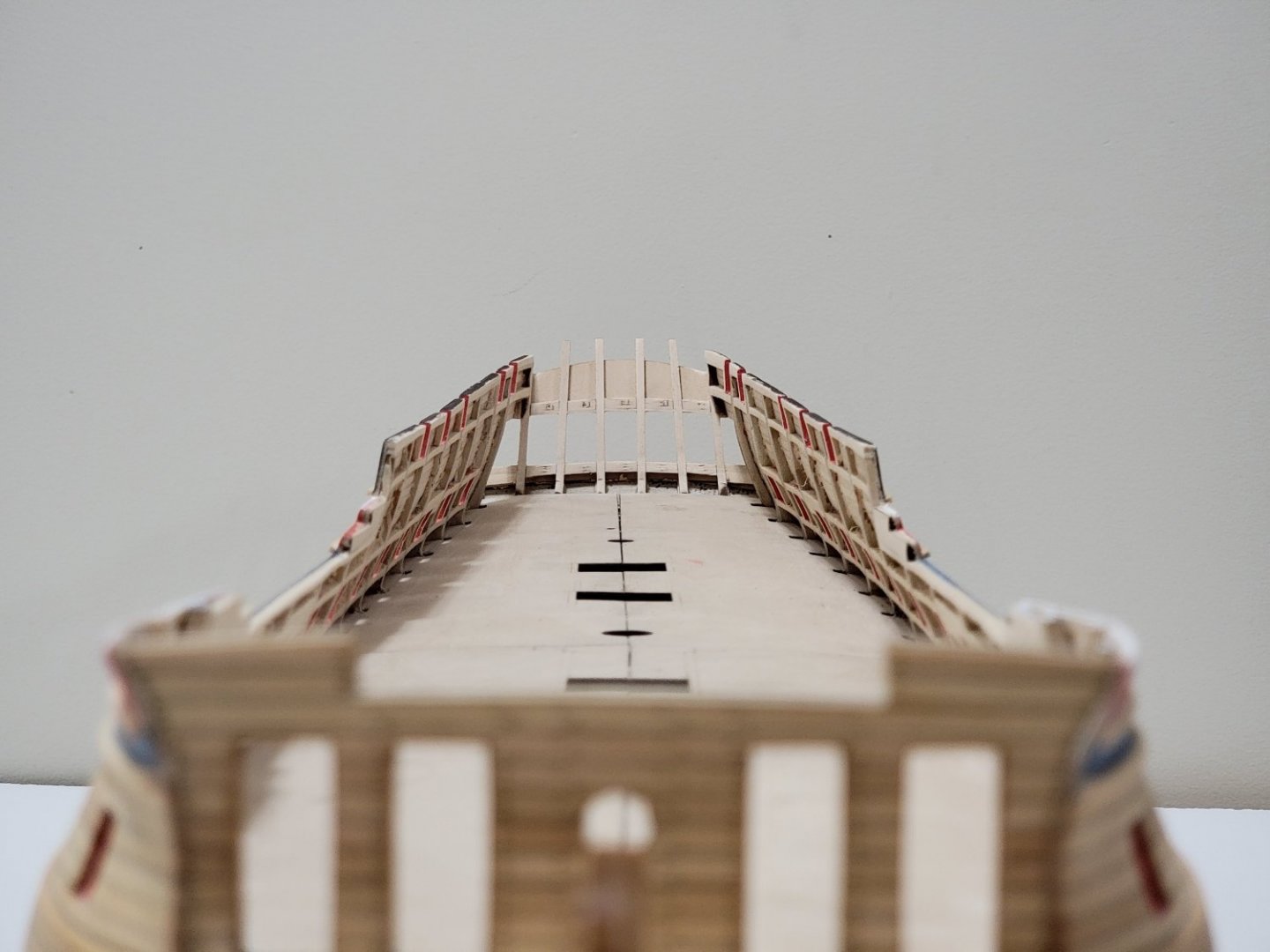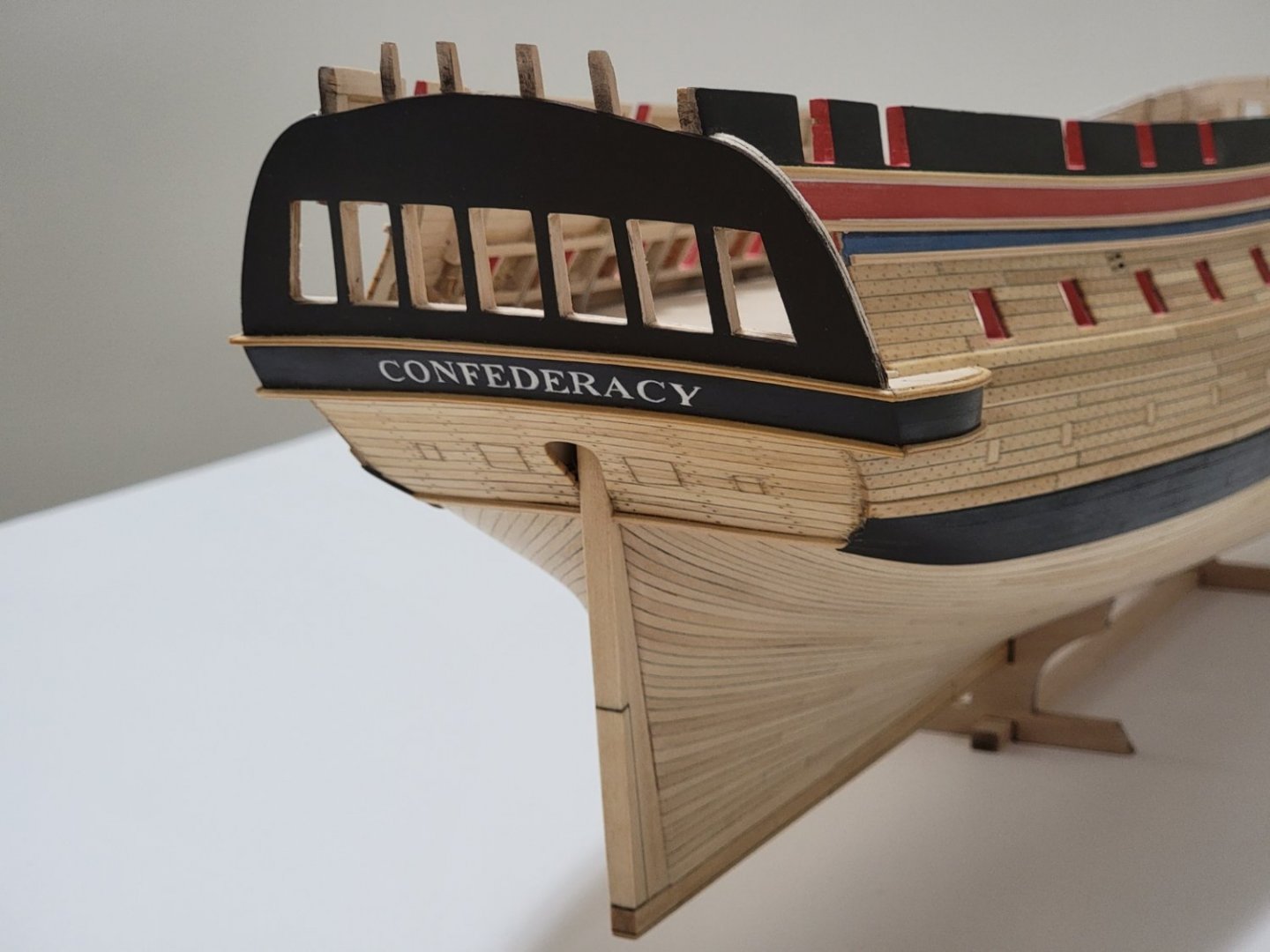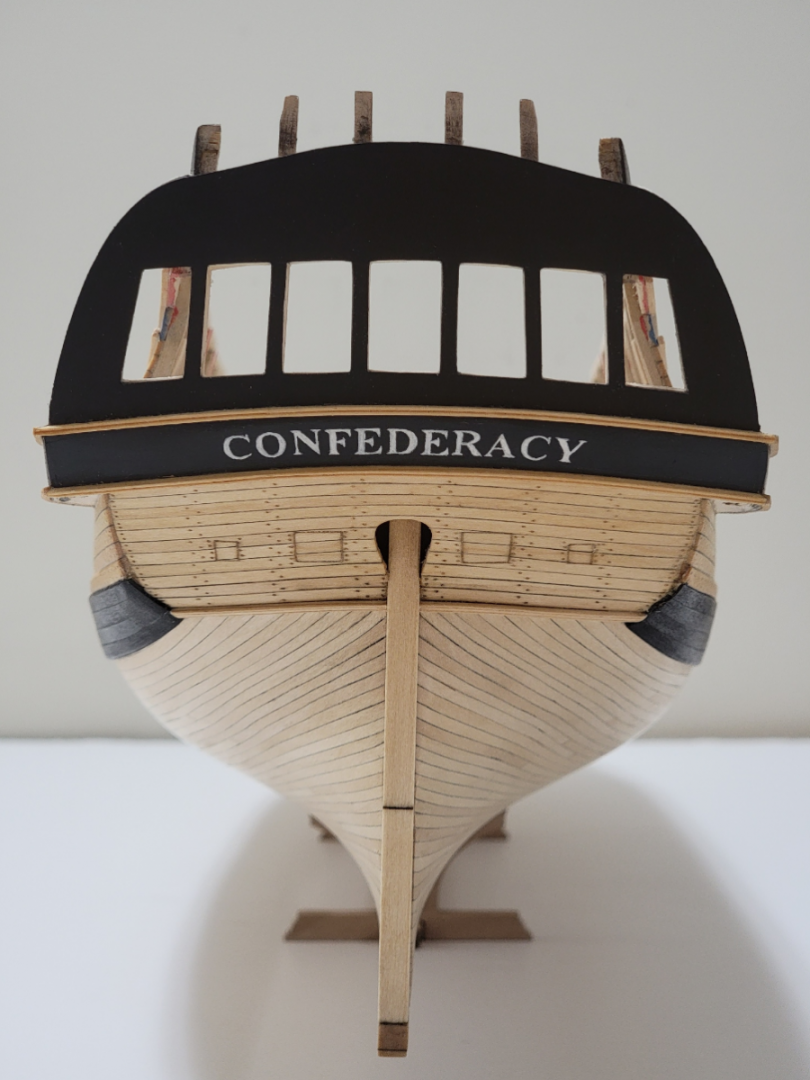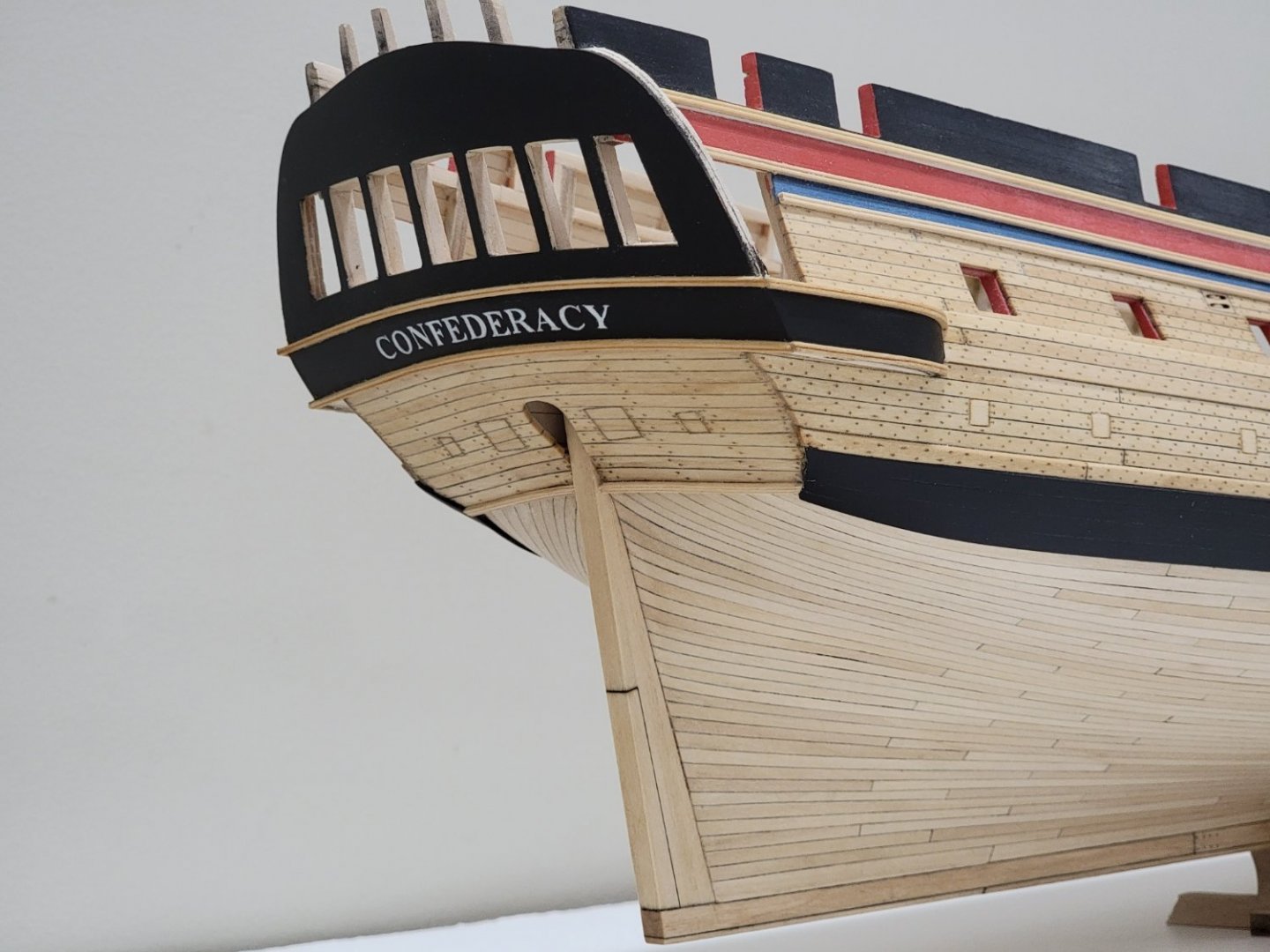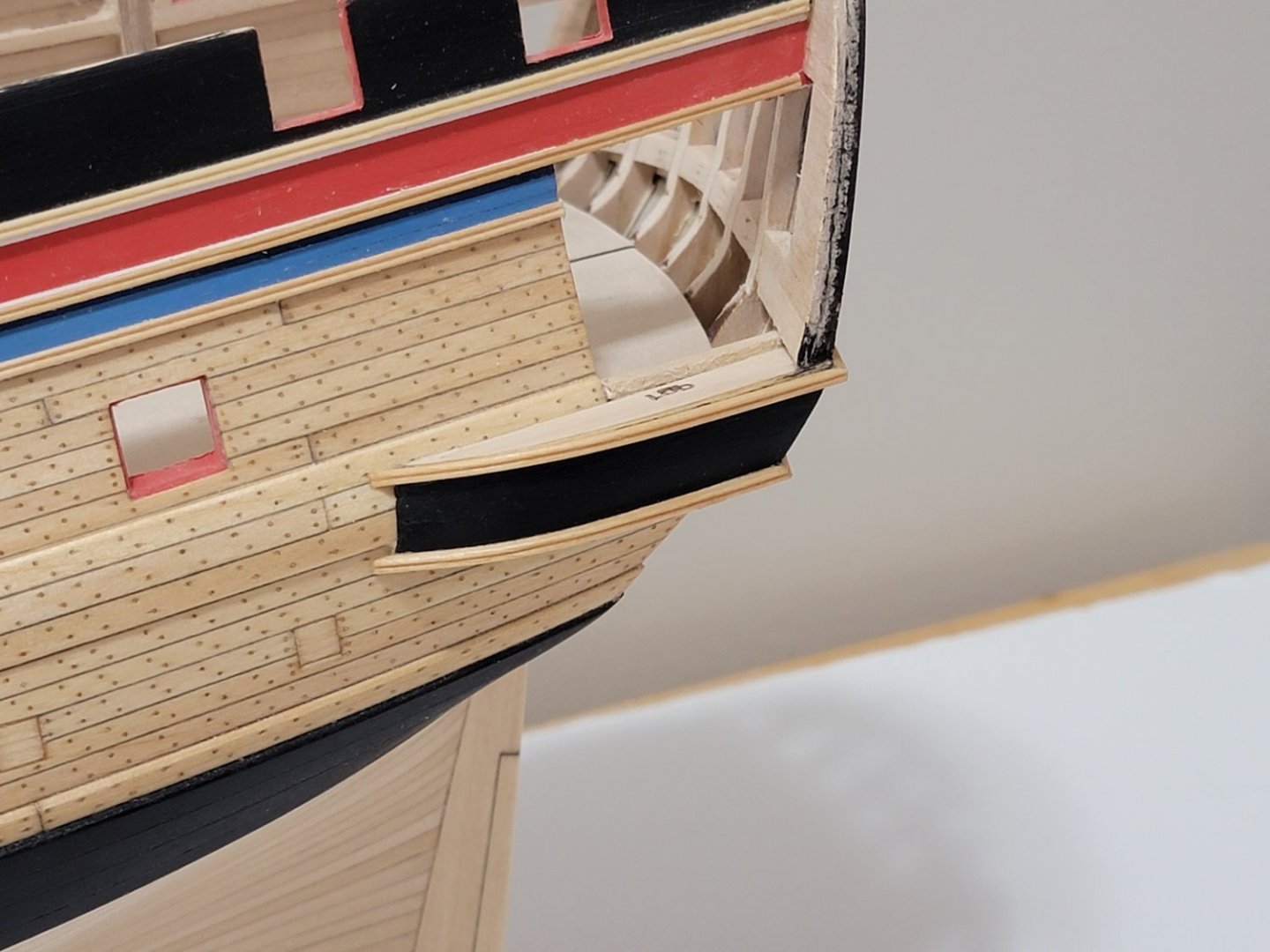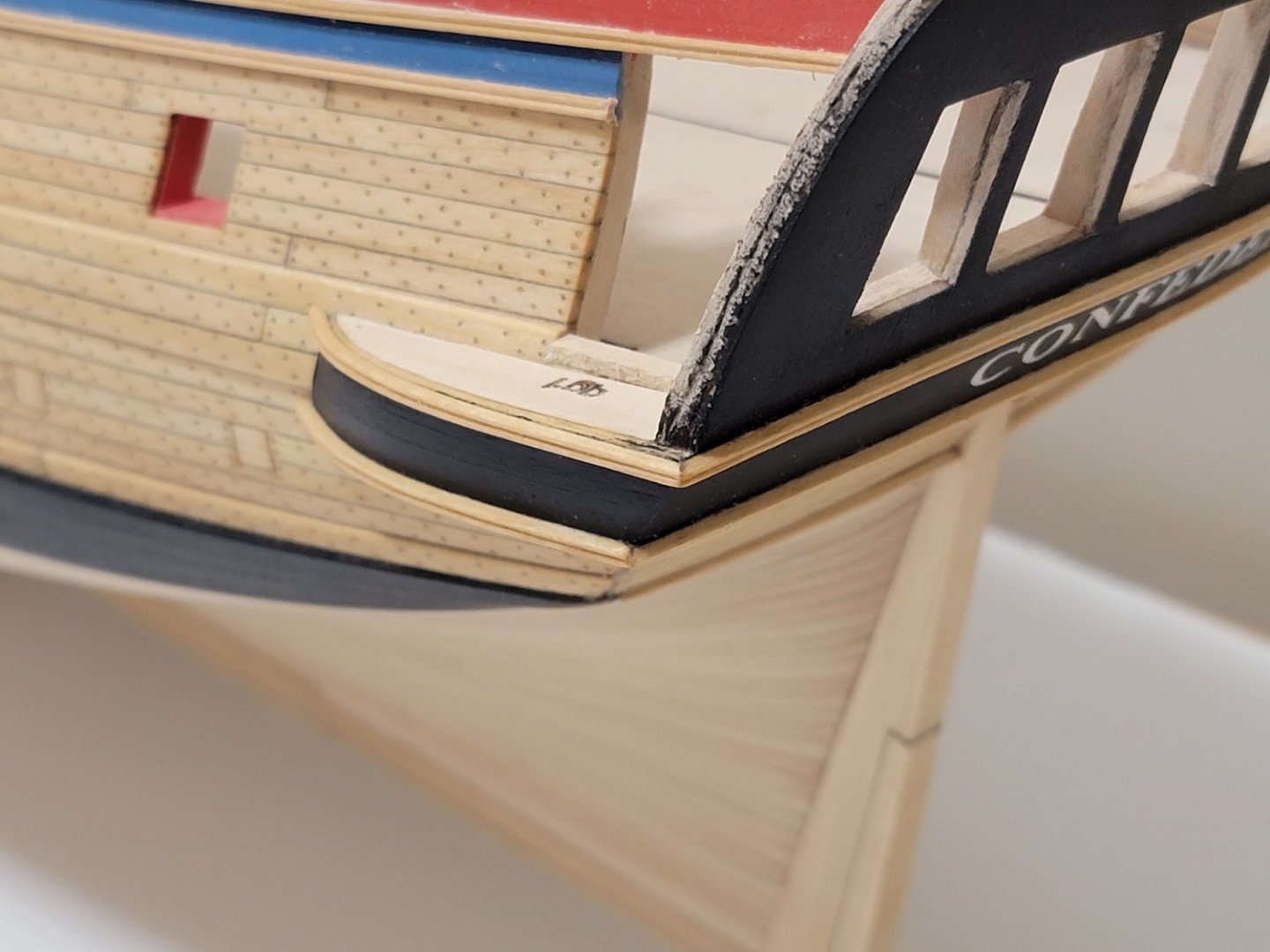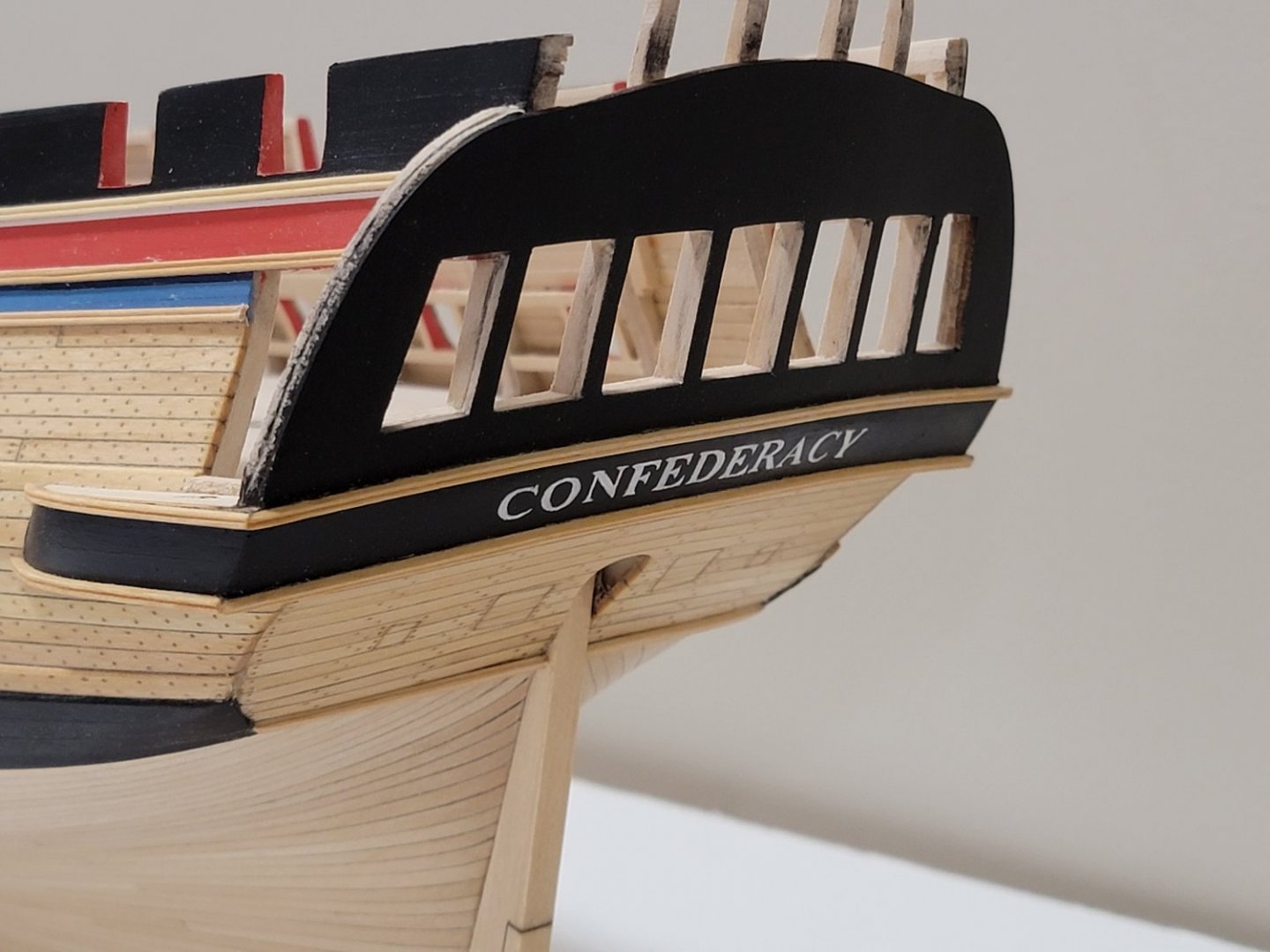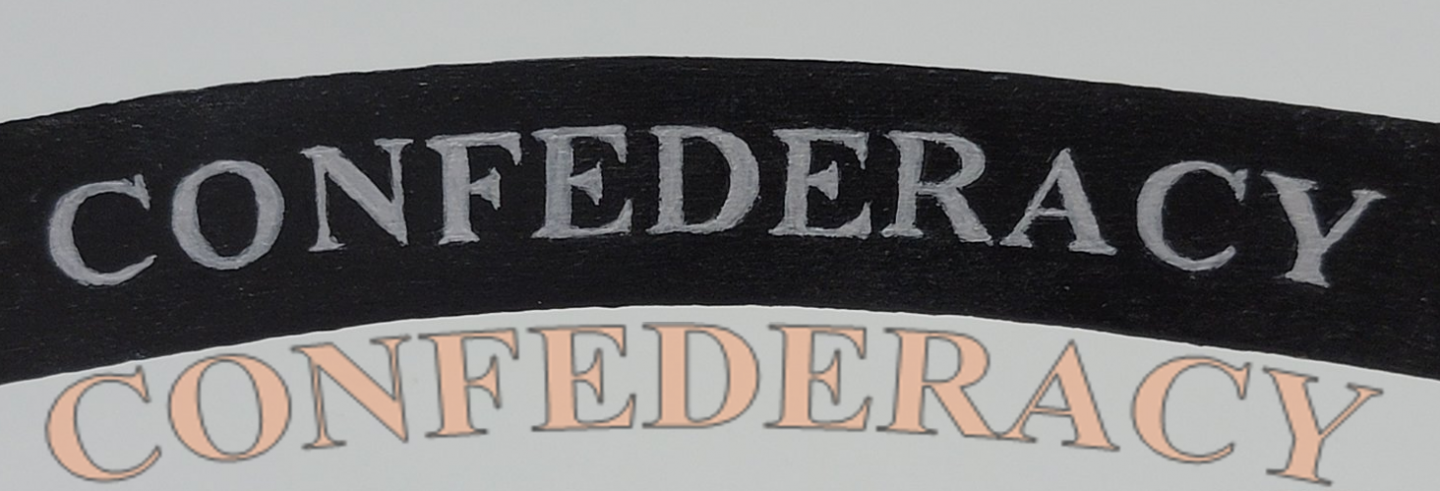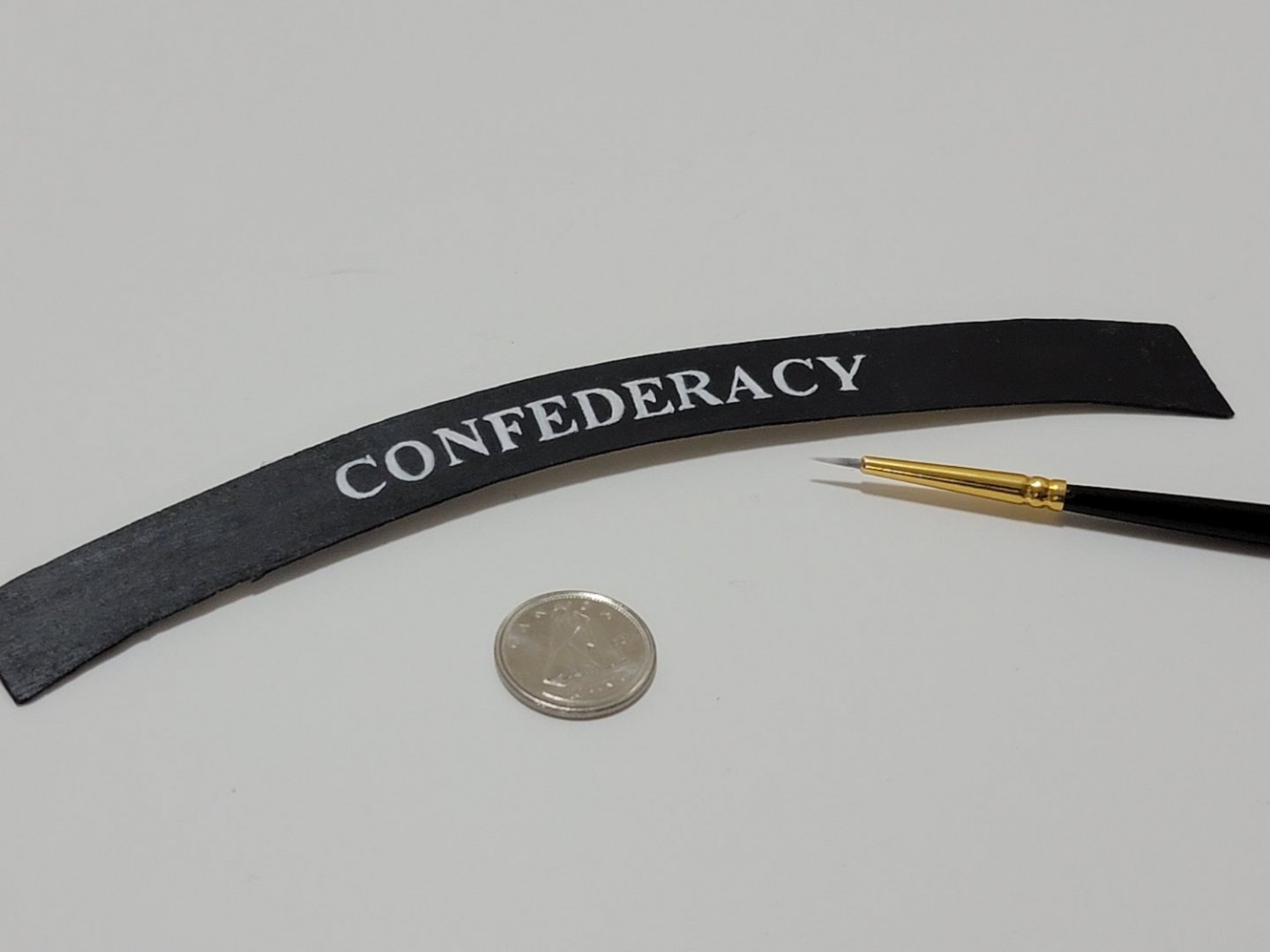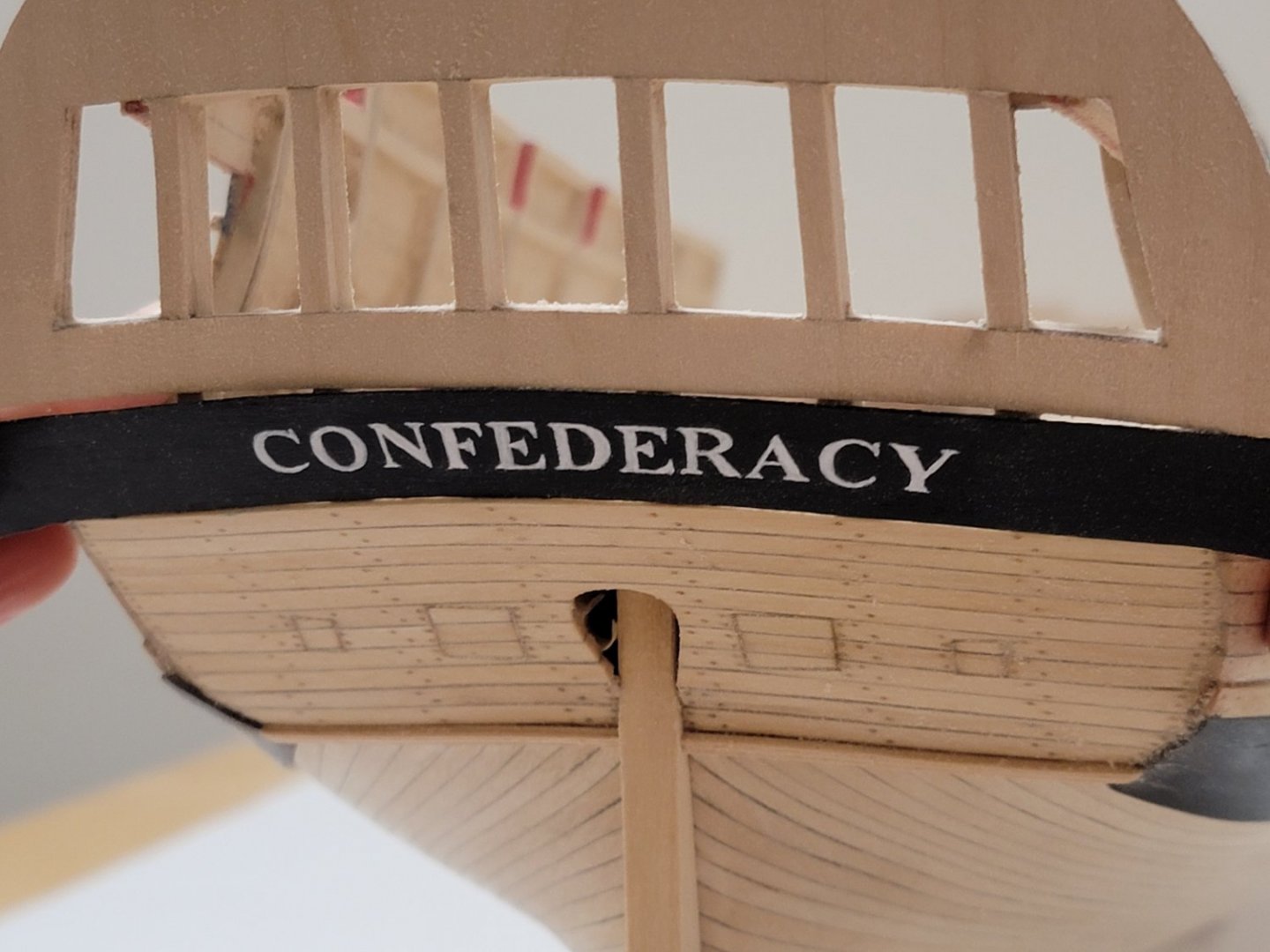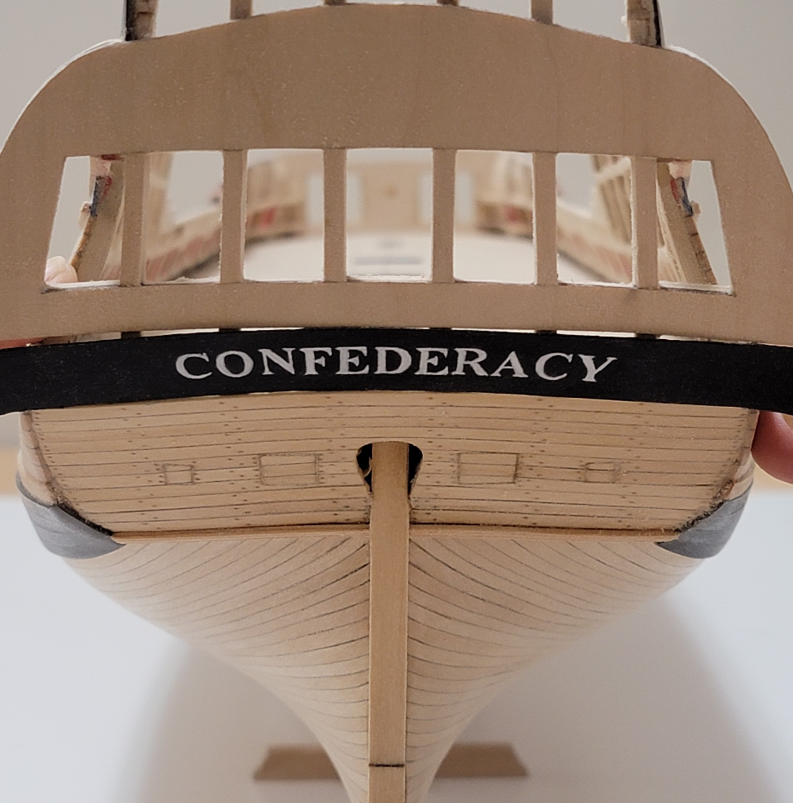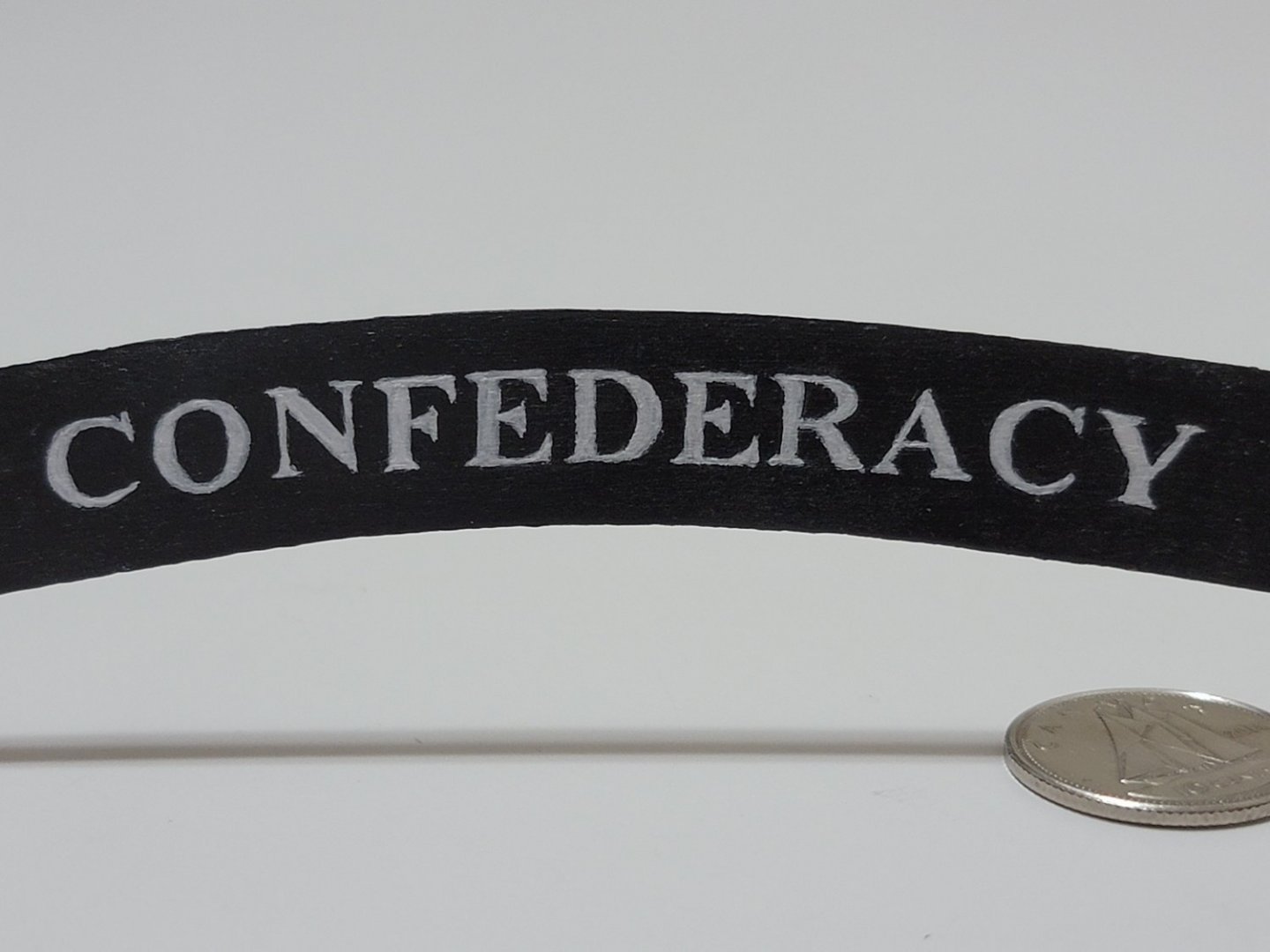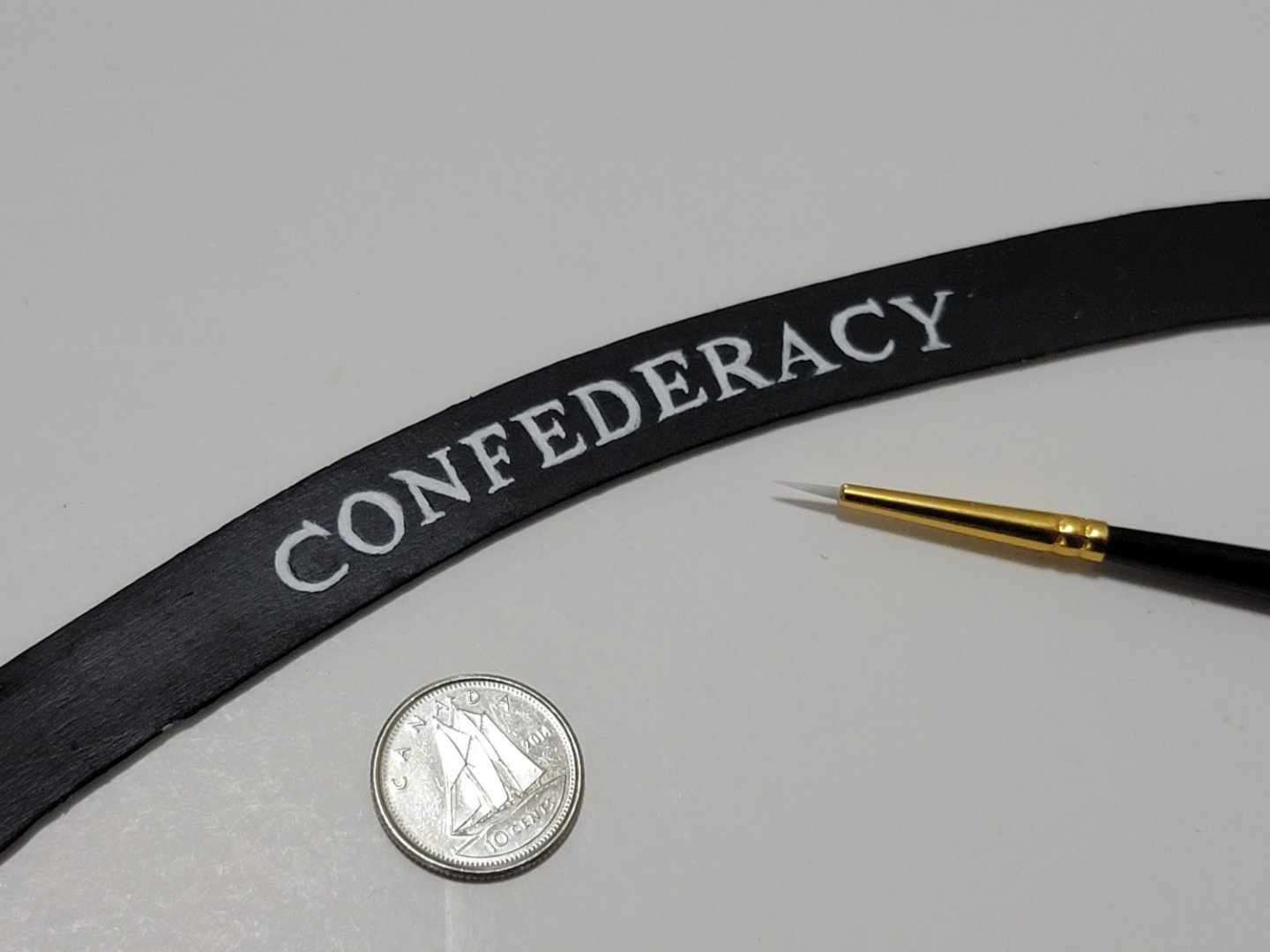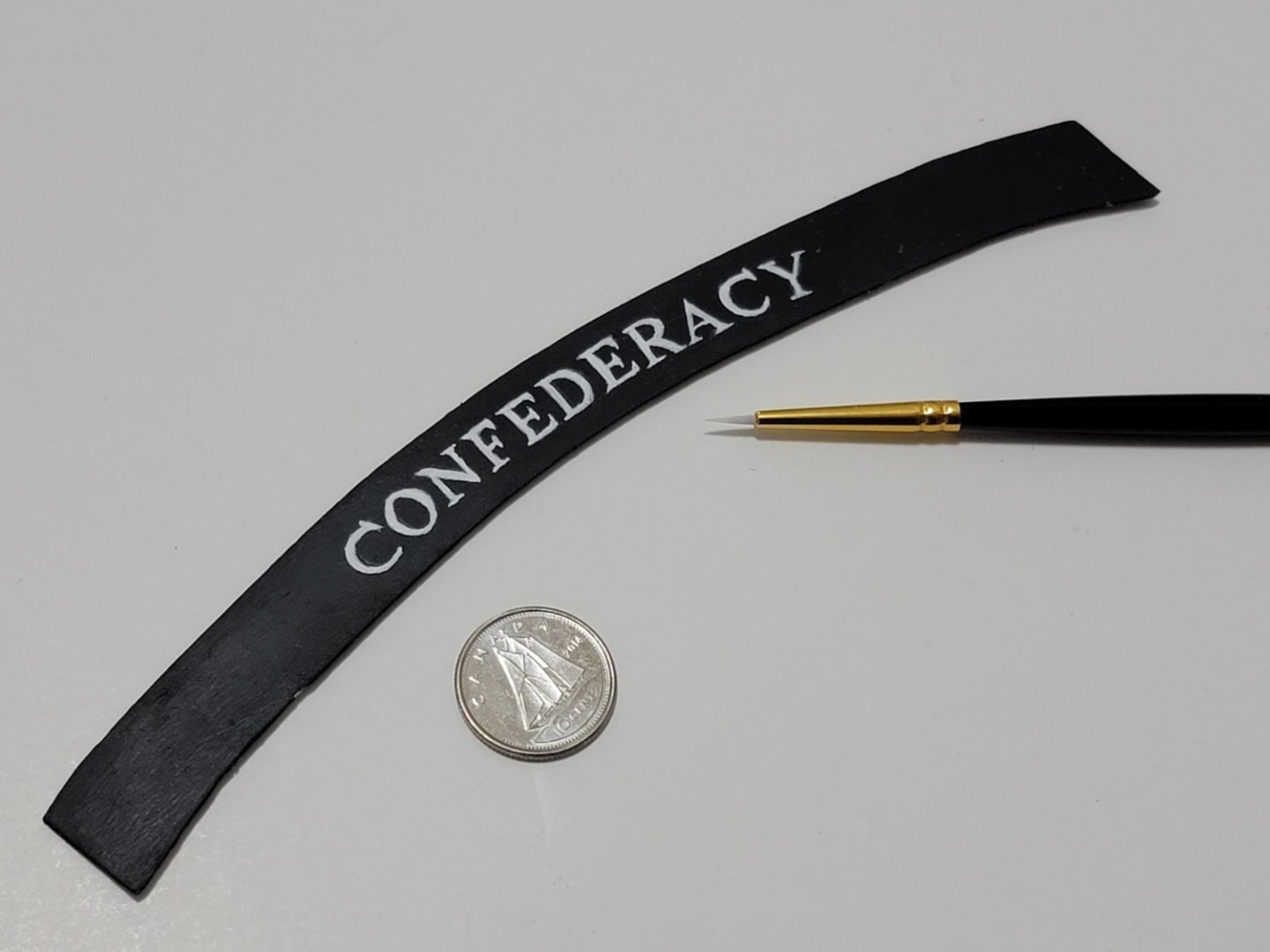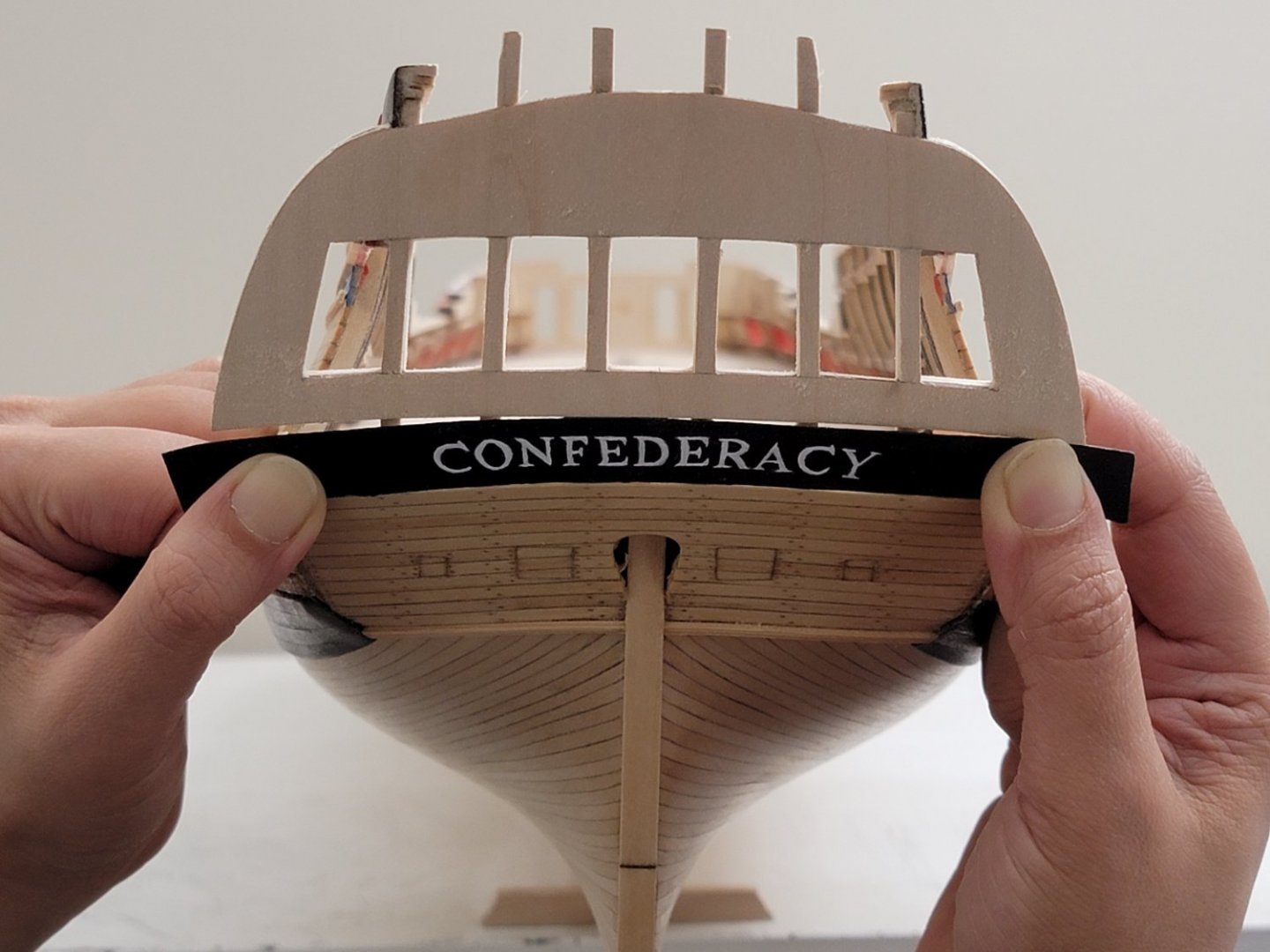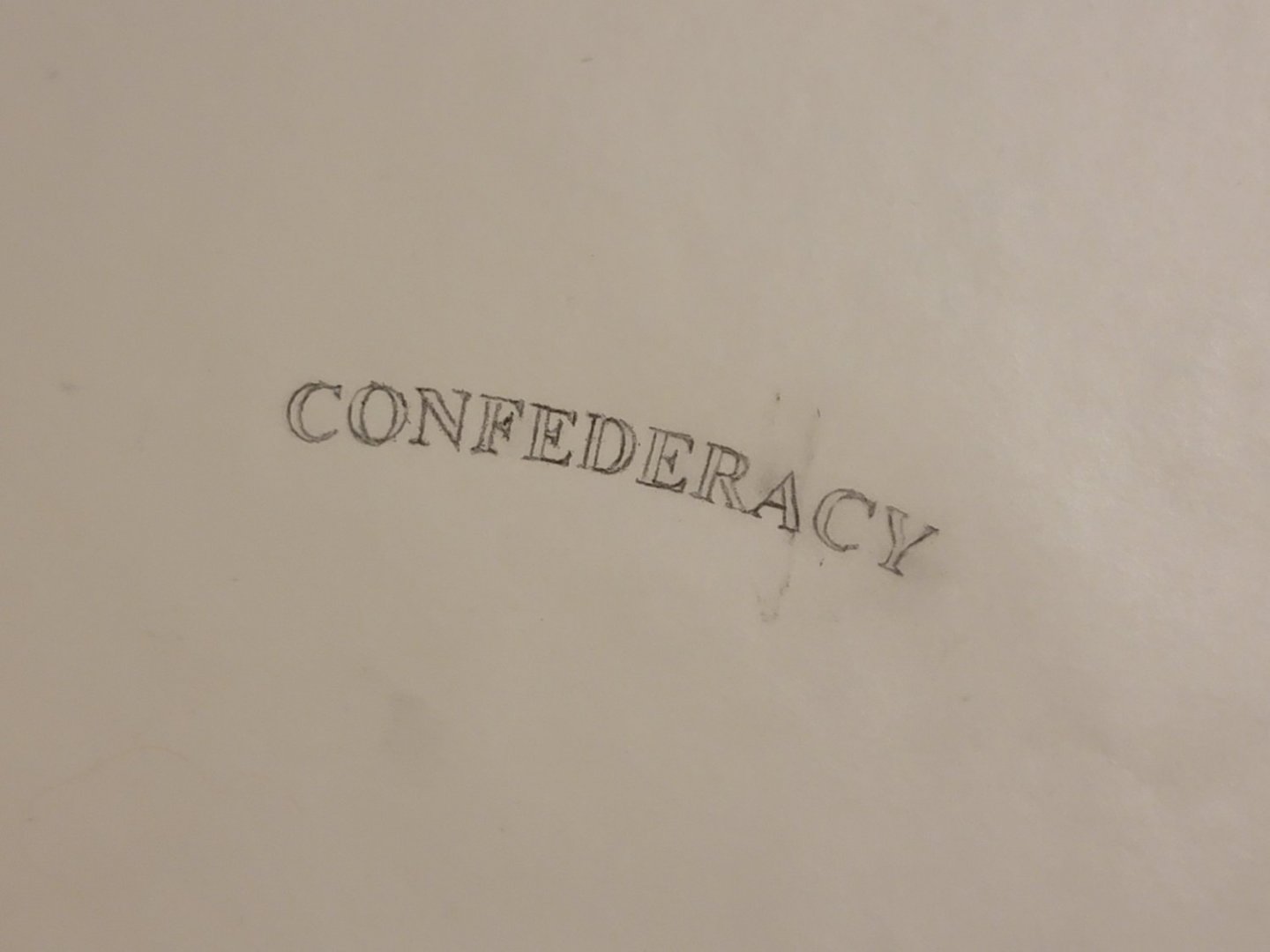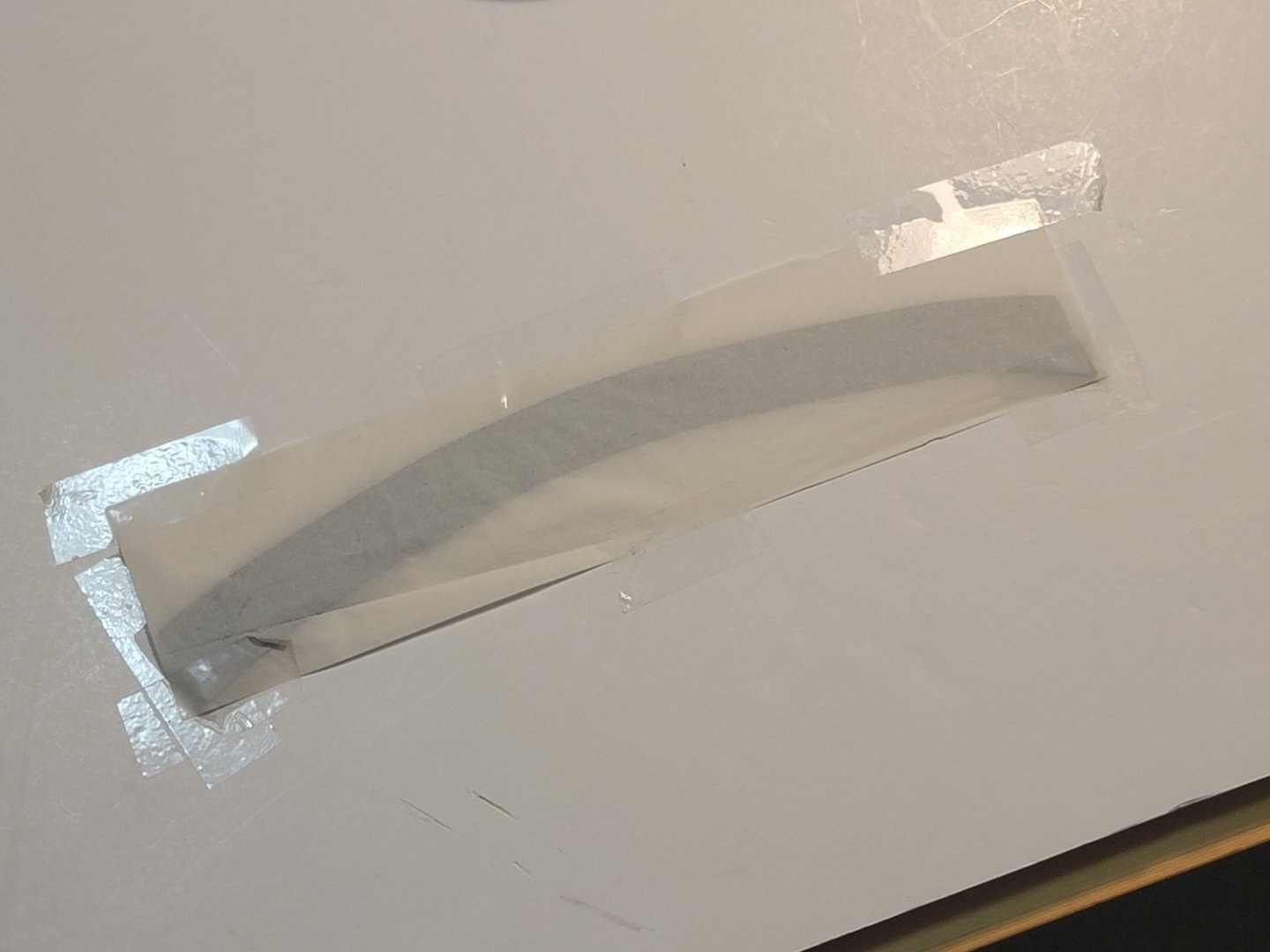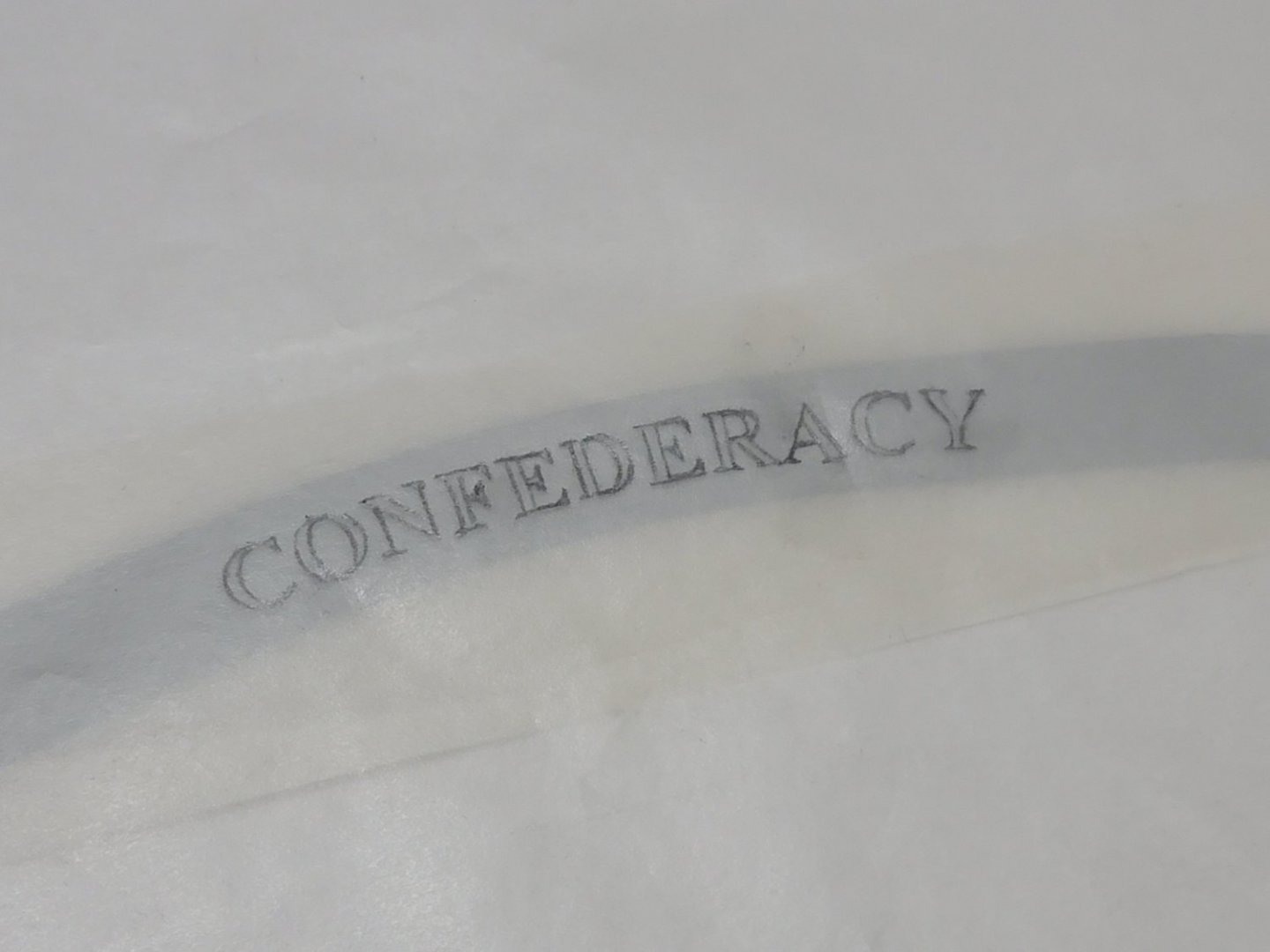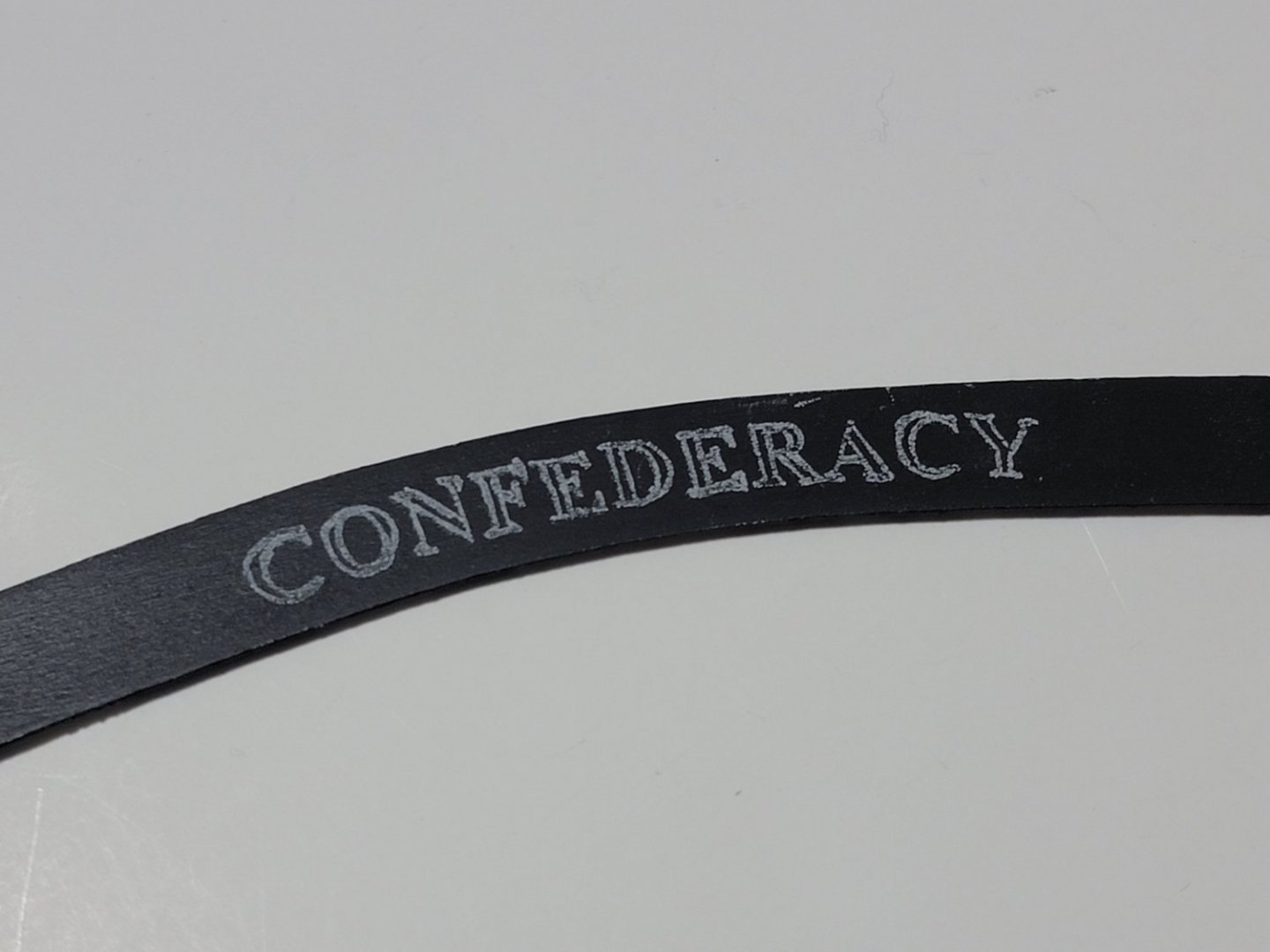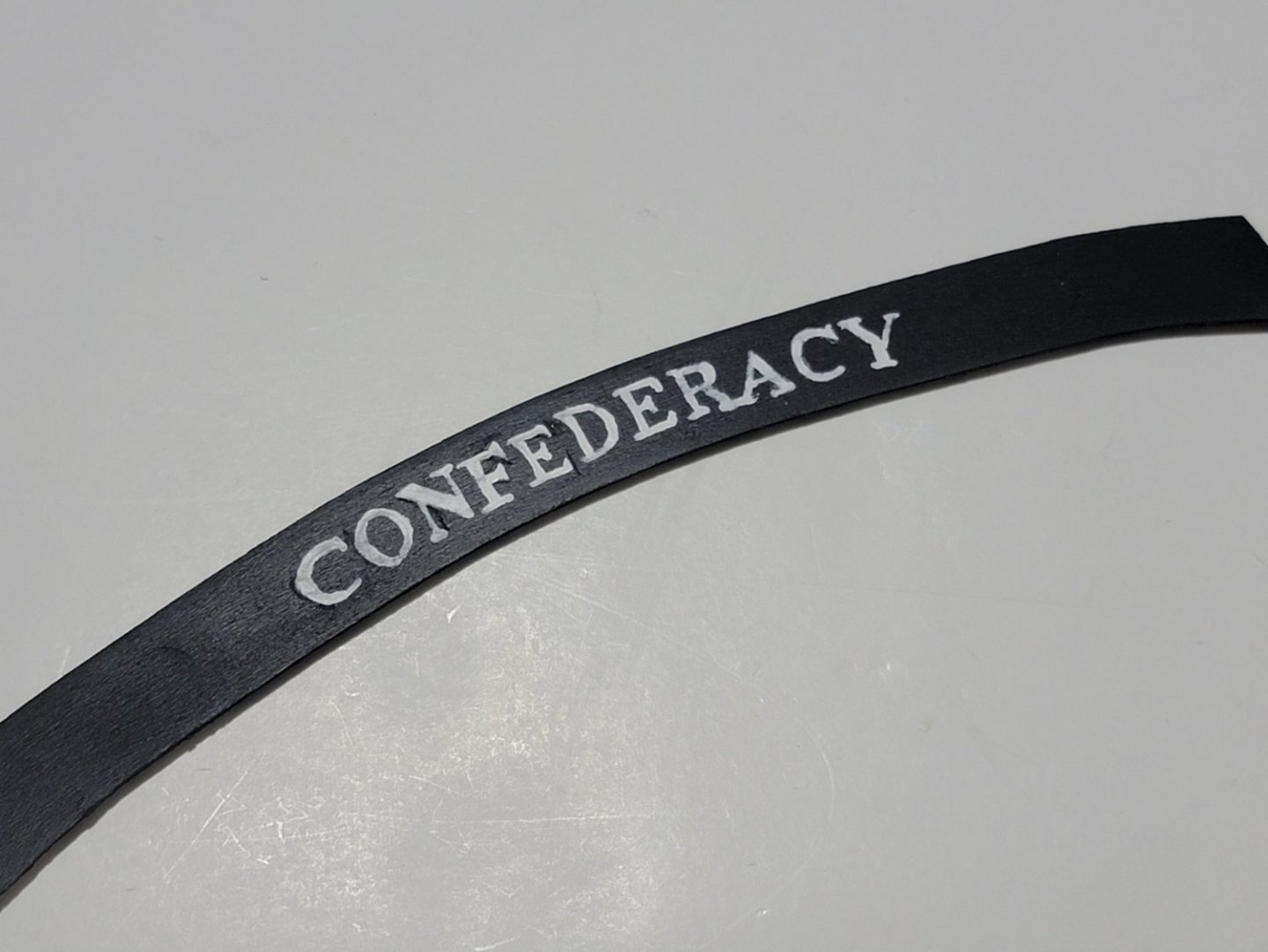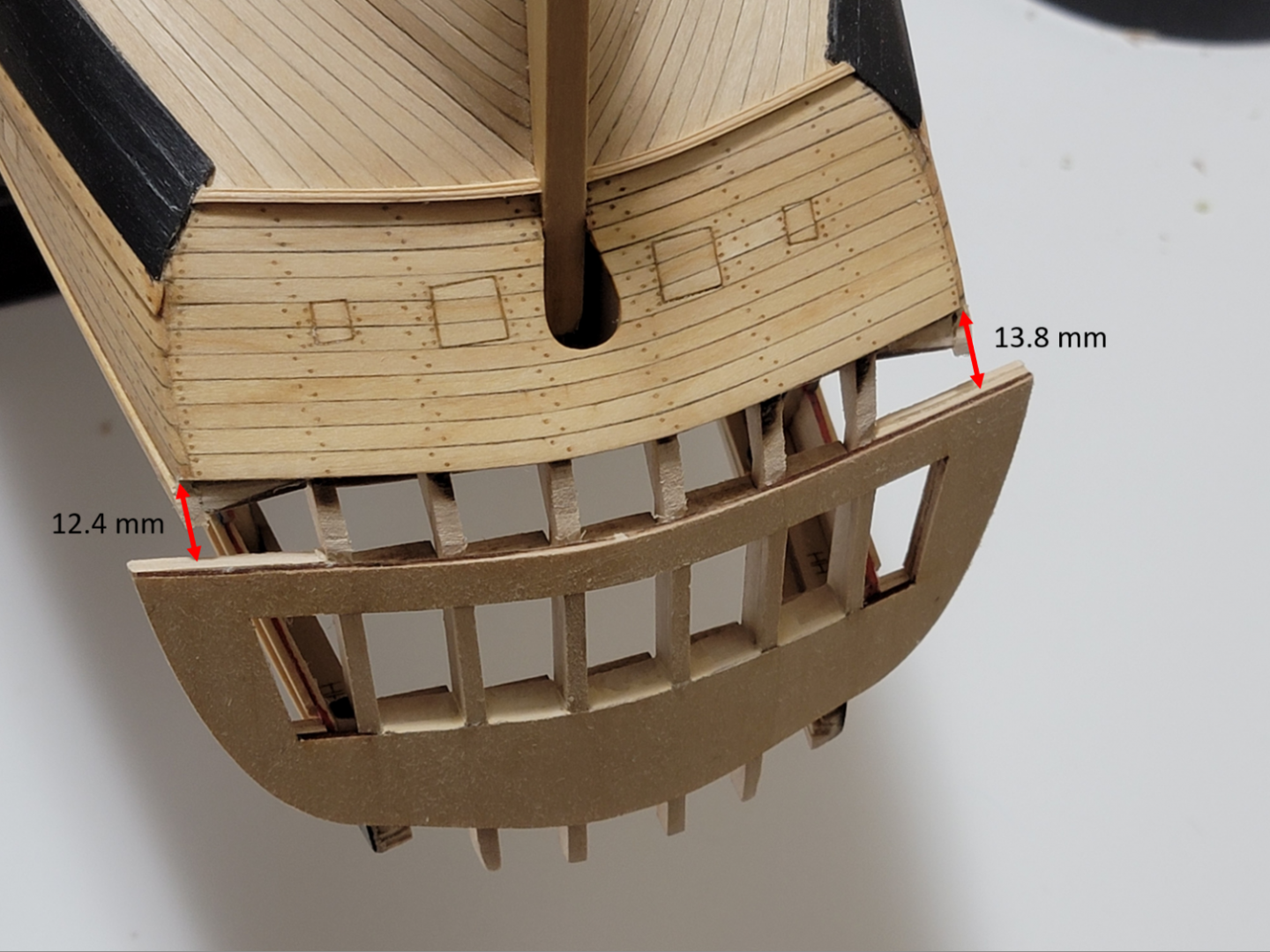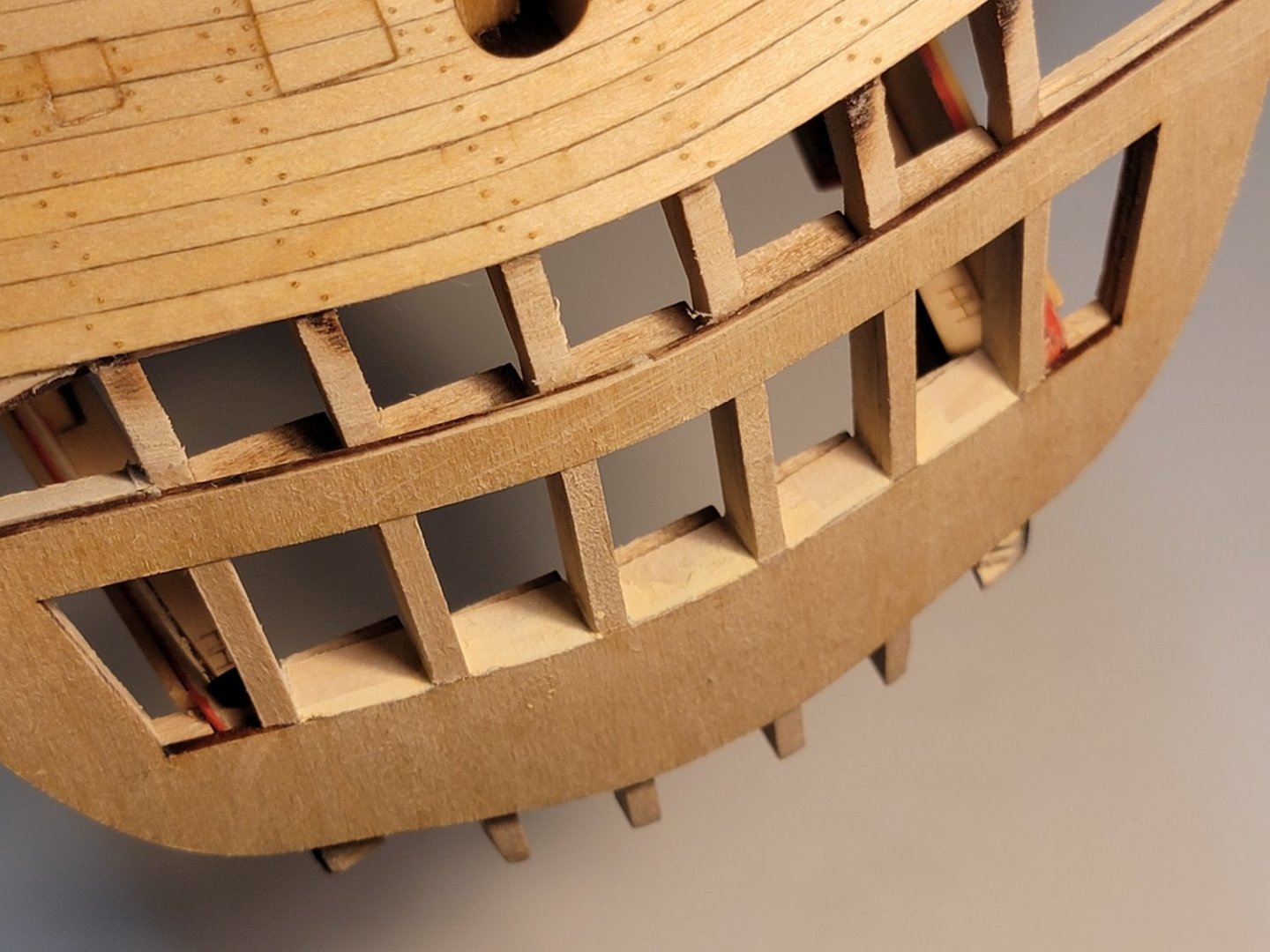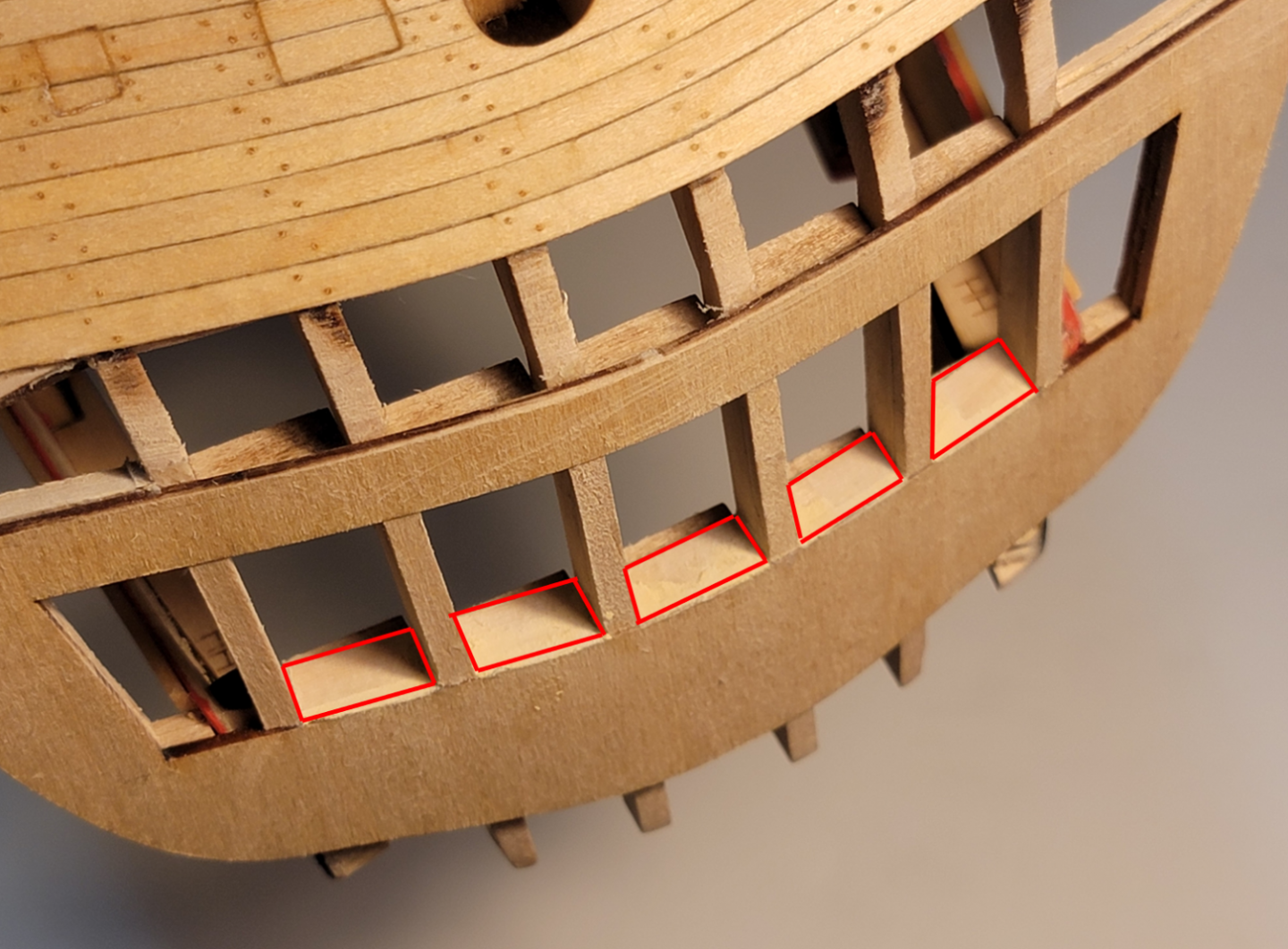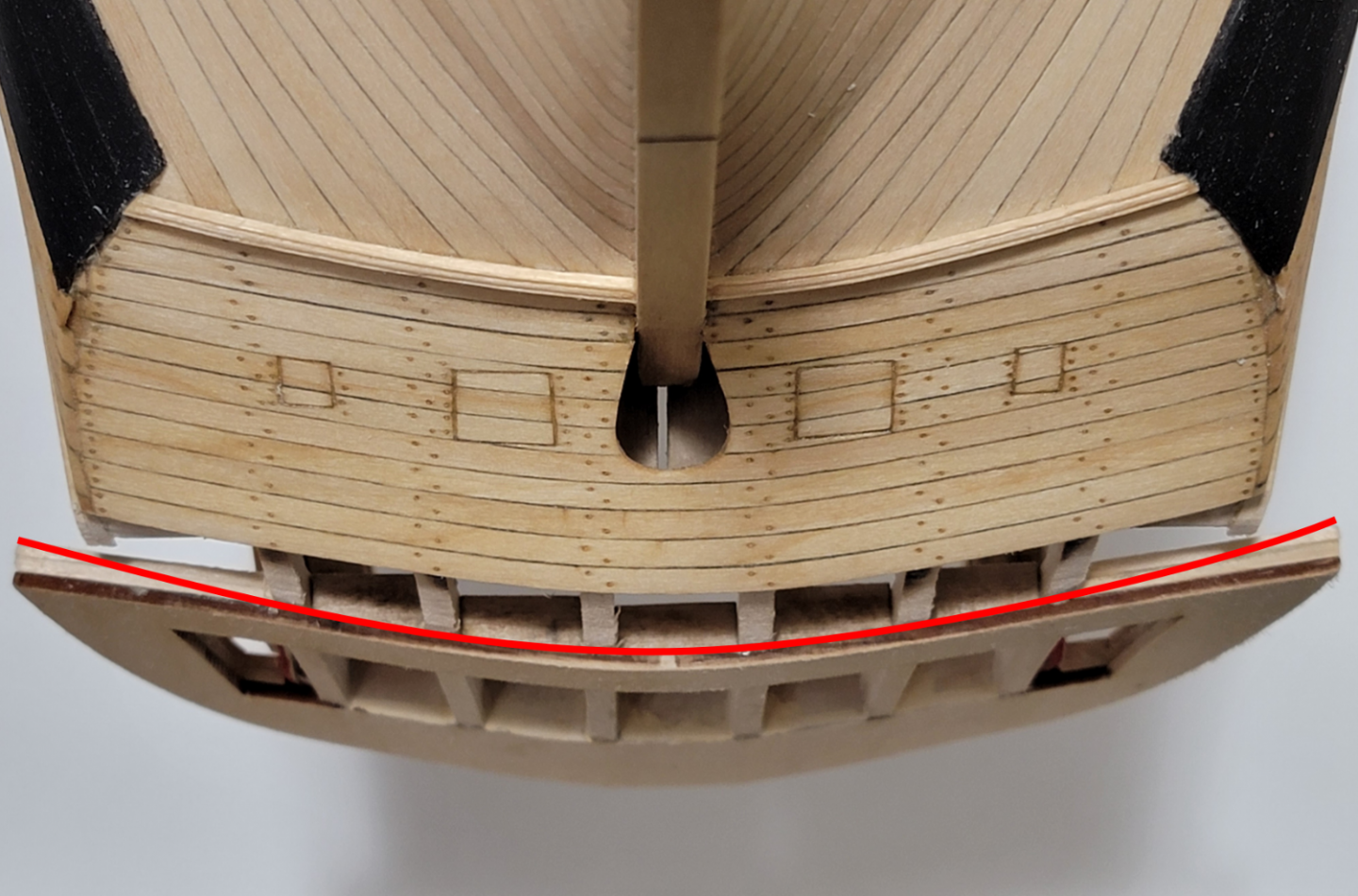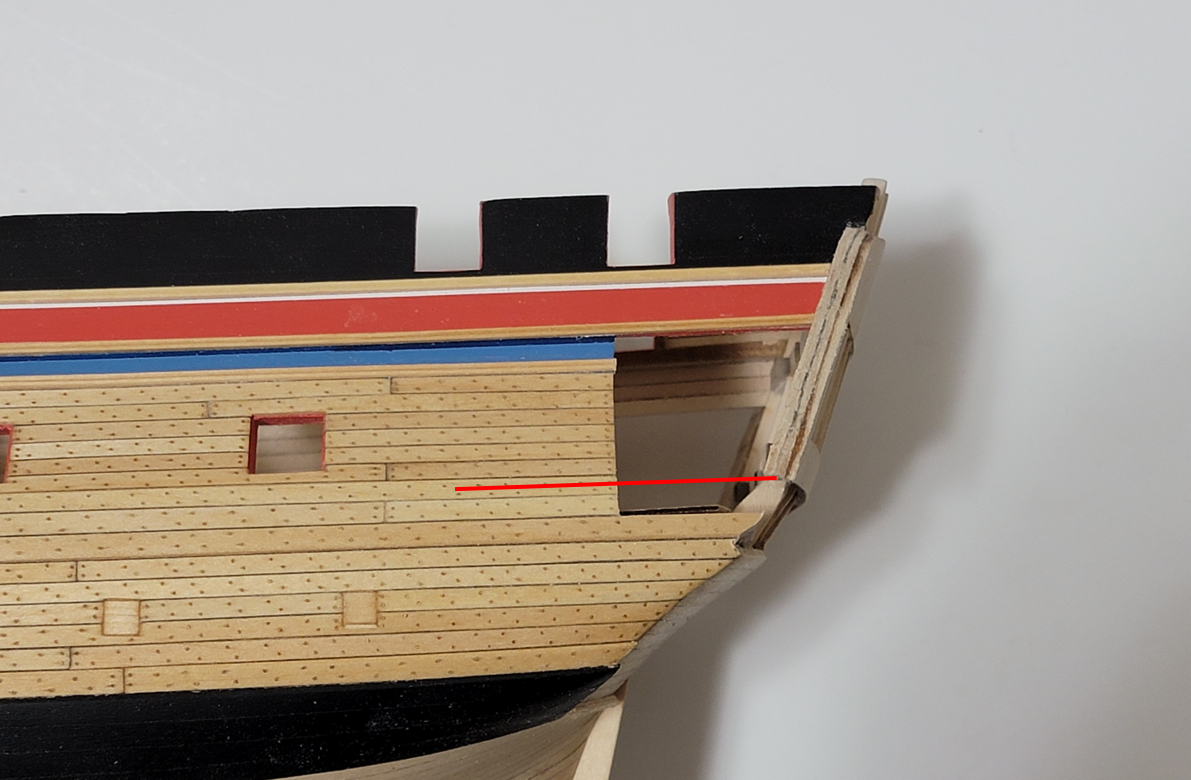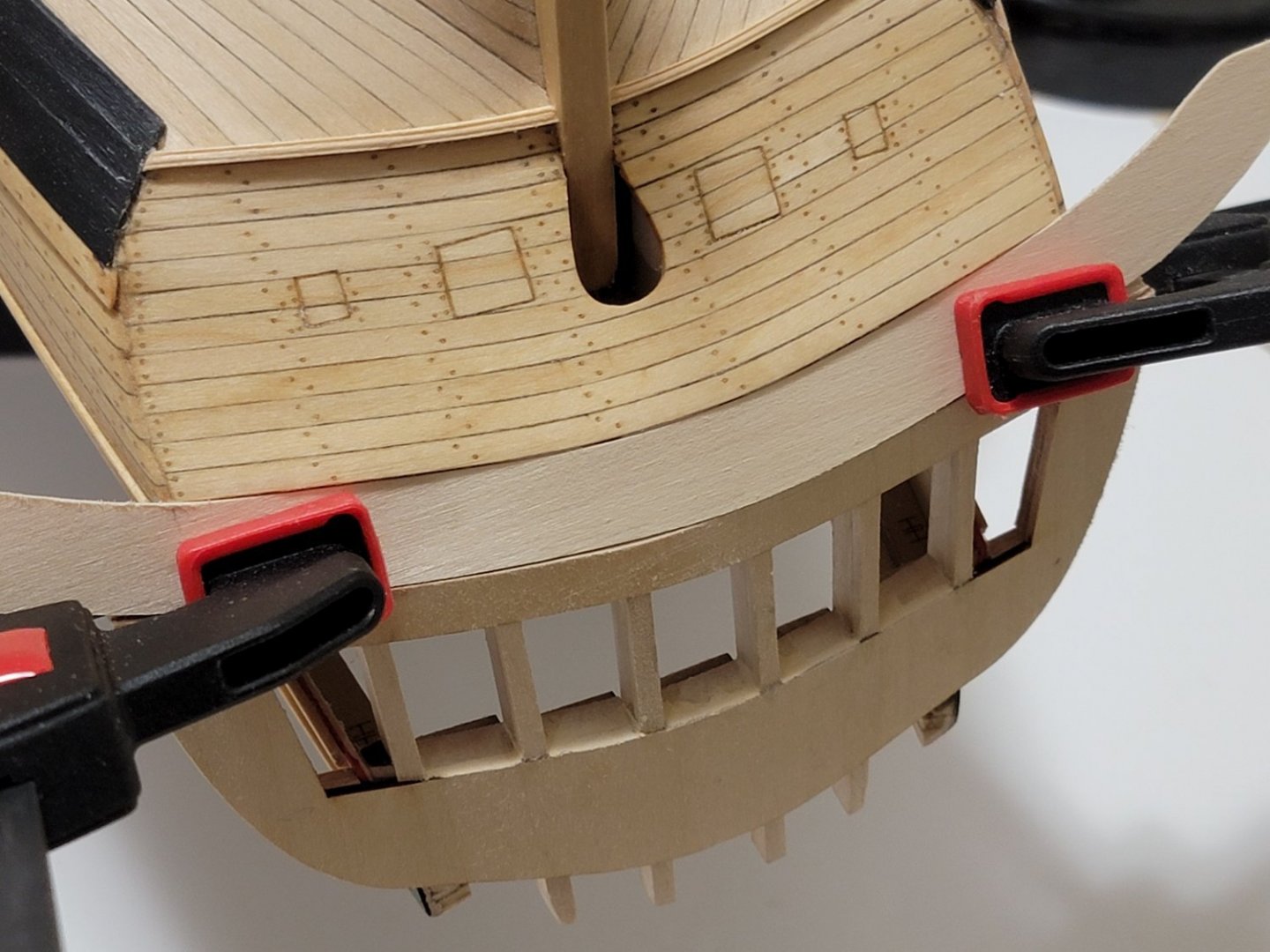-
Posts
1,009 -
Joined
-
Last visited
Content Type
Profiles
Forums
Gallery
Events
Everything posted by WalrusGuy
-
Hi Andy, thank you for pointing out these discrepancies. I'll have to check if I face the same issues with my build. I faced a lot of discrepancies with the quarter gallery construction since few of the supplied parts actually fit my model. I will also have to scratch build the shell on the sides of the QG. The 3/16" strip is a good solution and it will be very hard to notice a wider strip when its all painted and the added details. As for the fo'c'sle clamp, have you thought about the option to glue in an extra scrap piece of wood fore of the clamp so that the aft end matches? Filler could be used to hide the seams between the extra wood and the supplied cutout. I'm eager to hear what others also think about how to solve this.
-
Hi Michael, my jaw dropped seeing the boxwood gratings. Amazing!!
-
The stern area is now planked and sanded smooth. Glad I did it now than later on since I felt very cramped holding the planks in place. The opened area on the sides were very helpful to get a grip of the planks and for easy access to sand them. Also, I had to edge-bend the planks before gluing them since there are two axis that each planks bend in for them to match the light sills. I used filler wherever I saw some gaps between the frames and the planks. The molding strip was added next. The edges were first softened. Then, I glued the center part first and waited for the glue to set before bending and gluing the rest of the strip. I was first considering to continue on with the quarter gallery. Now after thinking for a bit, I am considering completing Chapter 9 to plank all the bulwarks. IMO, it seems to be the logical option as it would be better to finish the "messy" work before moving on. I know sanding the planks smooth will generate a lot of sawdust and it might be difficult to clean up from the lights. Once I finish planking, I'll paint the planks in the stern area white, and the rest red. I wanted to also note, the supplied shells for the quarter gallery do not fit my model at all so I will need to scratch build them. Something I need to think about while I plank the inside of the ship.
-
I hit a bit of a snag when further planking the Pickle. First, I was not too happy where the butt joints of the lower planking band was located. So I removed it and I am now following the Cheerful monologue to have a similar planking run. Once I deconstructed, I started planking the upper band. I have been using a lot of scrap wood to glue the neighboring planks. After reaching halfway, this method was not working. The curve of the planks was hard to achieve since there was little to no surface to glue them on, especially at the bow. Because of this, when sanding it, some planks at the bow became too thin and I sanded right through them: Here is a photo of the opposite side. I did not face this issue here. So now I am thinking of deconstructing the planking again, and will use balsa blocks to fill up the space between bulkheads. This way I will treat it as a solid hull model and will hopefully have an easier time planking.
-
Hi Steven, I am so sorry to hear of your loss. My sincere condolences to you and your family. You are doing a beautiful job with the rigging.
- 157 replies
-
- model shipways
- syren
-
(and 1 more)
Tagged with:
-
Thank you, Theodosius, David, Thomas, and Werner! Werner, thank you for pointing that out. I will rectify the error before planking the bulwarks. I found that the basswood sands much easier than the plywood pieces, so it is a bit difficult to get a consistent surface throughout. I'll try not to apply too much pressure now to obtain a gradual taper.
-
Hi Michael, your work always continues to inspire me! Everything is so crisp, tidy, and precise. Your work is not just model making but instead resembles actual construction in a smaller scale.
-
Thank you for the encouragement, Steven and Michael. And thank you all for the likes! 😁 I continued some more with the quarter gallery construction. Some scrap wood was inserted to create the 1/16" step since my planking was too low. Some scrap was also used to fill in the larger gap between the upper counter and transom: The other smaller gaps were filled in using filler: The quarter gallery counter was then planked, sanded, and painted black: I next worked on the mouldings. I used masking tape to act as spacer between the top and bottom mouldings. I applied tung oil once the glue was set. The mouldings for the quarter gallery counter were first bent then glued in position: Here are some photos of the initial steps completed: All the bulwarks have also been sanded to a maximum of 5/32" at the top and 7/32" at the deck level. Glad to have this part done with!! . I am thinking to paint the interior of the great cabin white, as well as the light frames. So I will start planking the bulwarks at the stern before continuing on with the quarter gallery.
-
Thanks all for the feedback! It's much appreciated!!! I overlaid text (with a slight contrasting color) on top of the painted area, and made the text slightly transparent so I can see the potential problem areas. It seems that the spacing was related to the font choice. The spacing may have been further amplified from both the curvature of the text as well as the shape of letter A because of the slanted lines.
-
Thank you for the suggestions and comments 🙂 The main reason I chose not to go ahead with the brass letters is that I wanted to try out new techniques. And I read somewhere (I can't remember where though!) that ships before 1800-ish had the ship's name painted on. Also, the brass letters looked a bit small on my model's counter. So as Werner pointed out, I based mine on Hahn's lettering when it comes to sizing. I took all of your suggestions and tried them out. I changed the font slightly by decreasing its height. Looks a lot more proportioned to my eye now! The first technique I tried was printing the white letters on a black background. This resulted in perfect lettering (of course!) but.. the black printed background did not match the acrylic paint in texture. So I tried different solutions like matte medium, but later learnt that printer ink is water soluble since everything smudged. I could have tried a matte fixative but I wanted to try out other techniques before going this route. Next, I tried to cut out a stencil on label paper. The paper just tore since the letters are so small to cut precisely. Then, I thought of printing out only the outer borders of the letters, then painting the surrounding black by hand. This resulted in a lot of brush strokes going in different directions which were clearly visible. Maybe this idea may have worked if I sanded inbetween each coat, but I wanted to try out other ways before doing more trials with this method. I also considered painting individual letterings (as panels), but as Eric pointed out, I was not too sure how to go about the uneven surfaces. Lastly, I considered purchasing the Roman R.R. Gold letters, but I was not too sure how to align them properly to have the proper kerning. So...... I thought I would try out the the painting technique again that I used previously before diving deeper with the other techniques. For this trial, I took more a lot more time with rewriting the letters on the white graphite paper (this time with a compass point for more precision) and even more time with each brush stroke when painting within the graphite marks. I applied 2-3 coats of white paint. I think it looks much better than before, and does not have the "funky" look that my previous attempt had. The decreased text height may have also helped with this. Any comments on this trial would also be appreciated. I think I am now tempted to glue this on (but I'll do it after I sleep on this decision!)
-
After a few more trials of using the acrylic paint pen, I decided to switch things up with a paint brush. I found the pen to be too wide for some parts of the letters. The brush allowed for more control. I would love to hear opinions on this trial. Does this look good? Should I go ahead with gluing it permanently? Or are more trials/fine tuning needed?
-
Thank you for the comments, Werner and John. John, I'll look into the decals if I am not satisfied with my paint trials. Thank you for providing the link 🙂 Apologies for the confusion, Eric. That was a mistake on my part. It should be "transom" not "transform". I'll edit my post. Here is my process for the lettering. This is my first try and hopefully I will get better results as I do more trials. 1) I traced the lower counter profile onto a paper, and used the curve as a guide to write the ship's name (this was done using the "Follow path" tool within "Text Effects" in PowerPoint. I placed the sketched image over my monitor and acquired the correct curvature needed. I have attached the PPT slide below if it helps anyone. The curve can be modified by resizing the textbox. I went through each font to see the one I liked best and ultimately picked Times New Roman in bold. I'm all ears if anyone has any other font suggestion! Ship name.pptx 2) I took my sketch of the lower counter, placed it on the screen, and zoomed in and out to obtain the correct letter sizing (by height and overall distance of the entire name) 3) Tracing paper was taped to the top and bottom of the screen, and I lightly used a pencil to get the correct letter shape. I did not want to print as getting the correct letter sizes would be more difficult than simply zooming in and out. 4) Next, I taped the painted upper counter piece in place, taped a white graphite paper around it, and then taped the tracing paper over that ensuing the text is centered. 5) Using a stylus, I rewrote the letters over the tracing. For this first trial, the tip was a bit blunt, and that caused the white lines to be a bit too thick. I will use a pointier tip for my next iteration. 6) Now for the hard part! I used a white acrylic pen (0.7mm is the smallest I could find) to "paint" inside the letters. Since the pen uses acrylic paint as ink, I used a toothpick to neaten some areas. I may have used a bit more force and that caused the visible lines in the photo below. After the paint dried up, I lightly used an eraser to remove the white graphite. I found the curved letters the trickiest to do. I sanded down the text area and will try again, hopefully clearing out some blotchiness having more consistent line thickness in the letters.
-
A very fine and beautiful model. Congratulations! Thank you for posting the progress of your build here. I find myself coming back to read your log as I progress with my own build.
- 126 replies
-
- Finished
- confederacy
-
(and 1 more)
Tagged with:
-
Very crisp work and craftsmanship! I realized the gun port lids have functioning hinges. Amazing!
- 60 replies
-
- Confederacy
- Model Shipways
-
(and 1 more)
Tagged with:
-
The quarter gallery construction is a lot more challenging that I initially thought! I am facing a lot of discrepancies when trying to construct the initial assembly. Even though the laser etched marks on the transom is aligned with the inner two frames, the distance between the transom and the counter planking is different on both sides. I think this will be hard to notice once it is all painted and the decorations are applied. The lintels were positioned slightly higher than the transom lintels. I have no idea why this happened since I used the plans to make sure they were right in the first place 😅. So I just added some thin wood pieces (shown in the red boxes) and applied filler to hide it. I hope this does not affect the construction of the upper deck... When looking vertically at the transom , it does not have a smooth flow. This is because of the filler strips that were added on each side were thick, so that prevented the transom to have its natural curved shape. Sanding it to shape might help with this. The red line shows the shape it needed to be: Lastly, the counter for the quarter gallery sides also are way off that the instructions show. I saw this happen to other builds too, and filler planks were used to cover the gap. The red line shows where the upper part of the side counter should go for it to meet the lower part of the transom. My model shows the line much higher than the channel wales, and the instructions have it below the wales: After a lot of thinking on how to solve all of these issues, I decided to go about making the upper counter. I used card stock to get the general shape, then cut out the section on 1/16" basswood. I have used the clamps to hold the piece in position, and it is not glued yet. It seems a bit too wide, but it matches with the dimensions from Hahn's plans. So I think I am safe with that part. I also want to try have the ship's name painted, so having a thicker section will help with larger letters.
-
I think that's a bug on the platform MSW is on. See this thread: When I get the error I use the "Snipping Tool" and paste the snapshot. That seems to work for me.
- 60 replies
-
- Confederacy
- Model Shipways
-
(and 1 more)
Tagged with:
-
Hi Werner, thank you for posting the photos here. I have been actively checking the German forum to see if you have posted updates. The 12 pounder guns look really good. Did you use the kit supplied guns? And did you make the rope yourself? The furniture in the great cabin look amazing. Beautiful build!
- 60 replies
-
- Confederacy
- Model Shipways
-
(and 1 more)
Tagged with:
About us
Modelshipworld - Advancing Ship Modeling through Research
SSL Secured
Your security is important for us so this Website is SSL-Secured
NRG Mailing Address
Nautical Research Guild
237 South Lincoln Street
Westmont IL, 60559-1917
Model Ship World ® and the MSW logo are Registered Trademarks, and belong to the Nautical Research Guild (United States Patent and Trademark Office: No. 6,929,264 & No. 6,929,274, registered Dec. 20, 2022)
Helpful Links
About the NRG
If you enjoy building ship models that are historically accurate as well as beautiful, then The Nautical Research Guild (NRG) is just right for you.
The Guild is a non-profit educational organization whose mission is to “Advance Ship Modeling Through Research”. We provide support to our members in their efforts to raise the quality of their model ships.
The Nautical Research Guild has published our world-renowned quarterly magazine, The Nautical Research Journal, since 1955. The pages of the Journal are full of articles by accomplished ship modelers who show you how they create those exquisite details on their models, and by maritime historians who show you the correct details to build. The Journal is available in both print and digital editions. Go to the NRG web site (www.thenrg.org) to download a complimentary digital copy of the Journal. The NRG also publishes plan sets, books and compilations of back issues of the Journal and the former Ships in Scale and Model Ship Builder magazines.

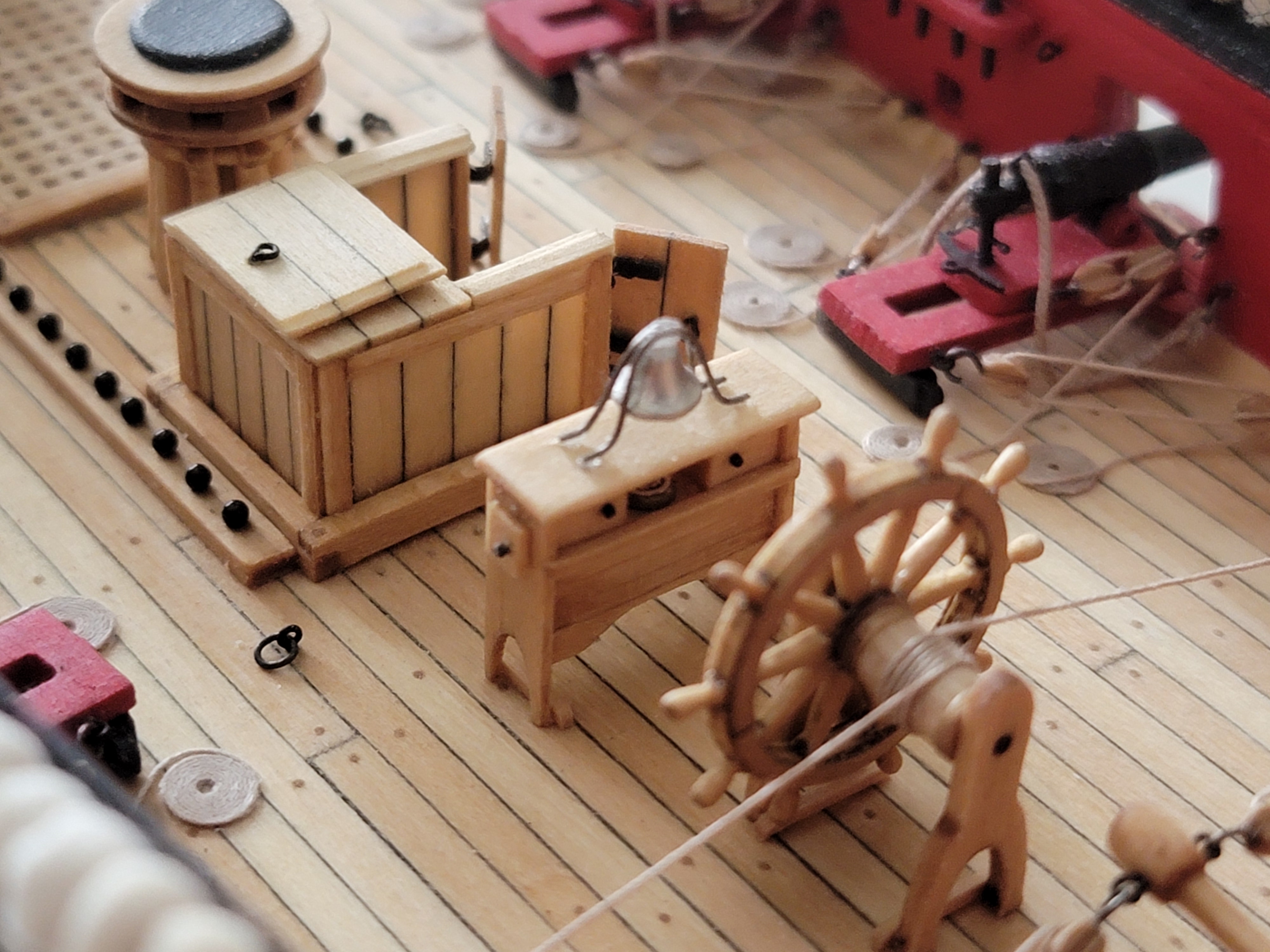
.thumb.jpg.62d1d69fed1f32364417cb1f9cdeb009.jpg)

